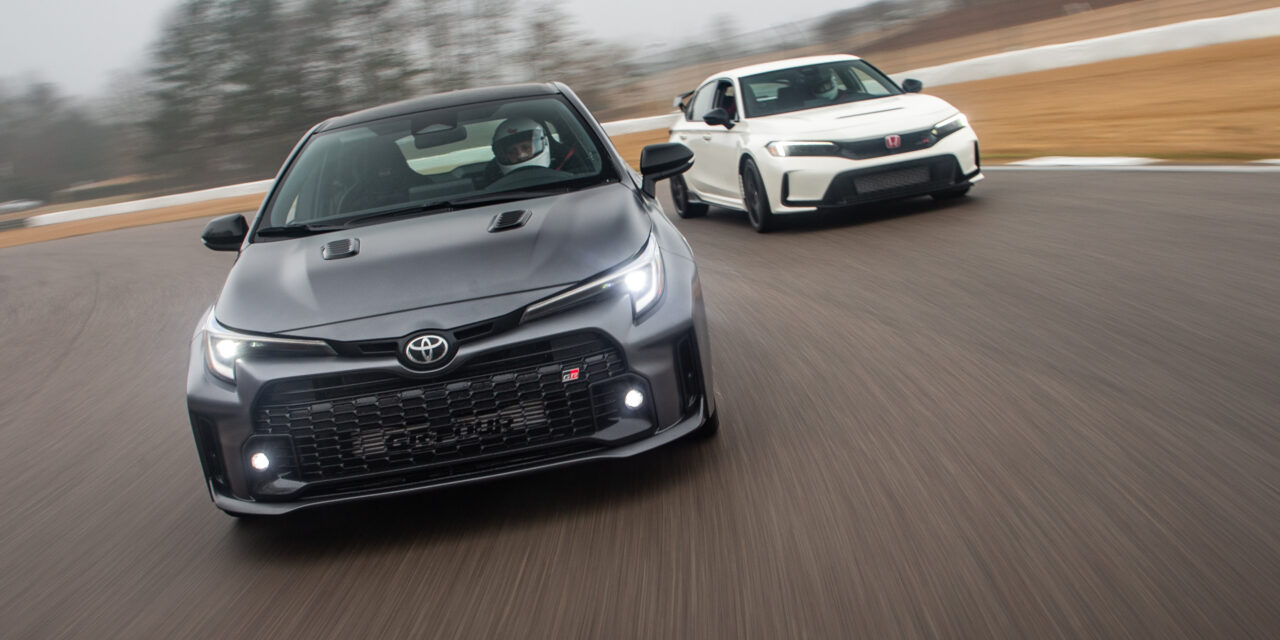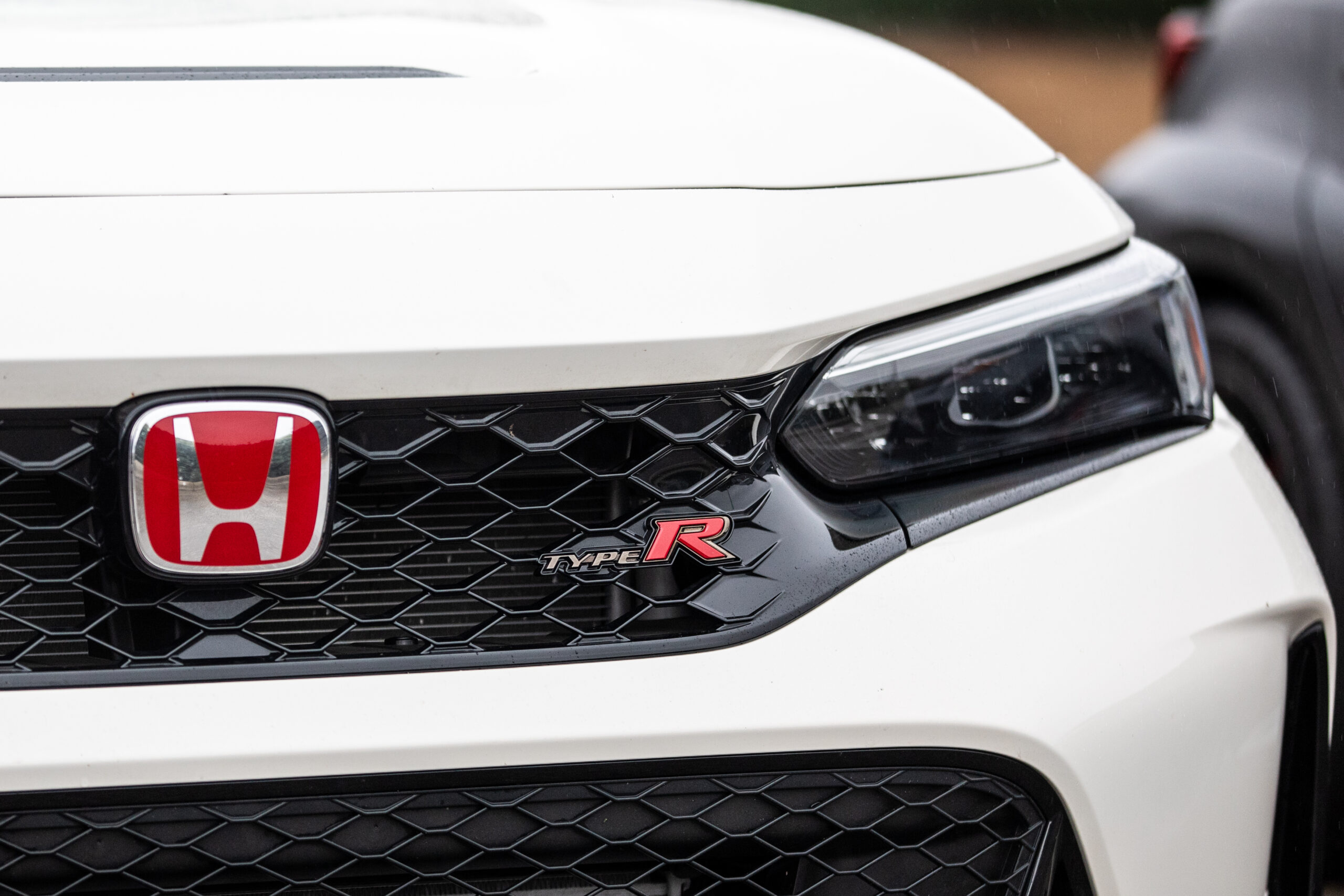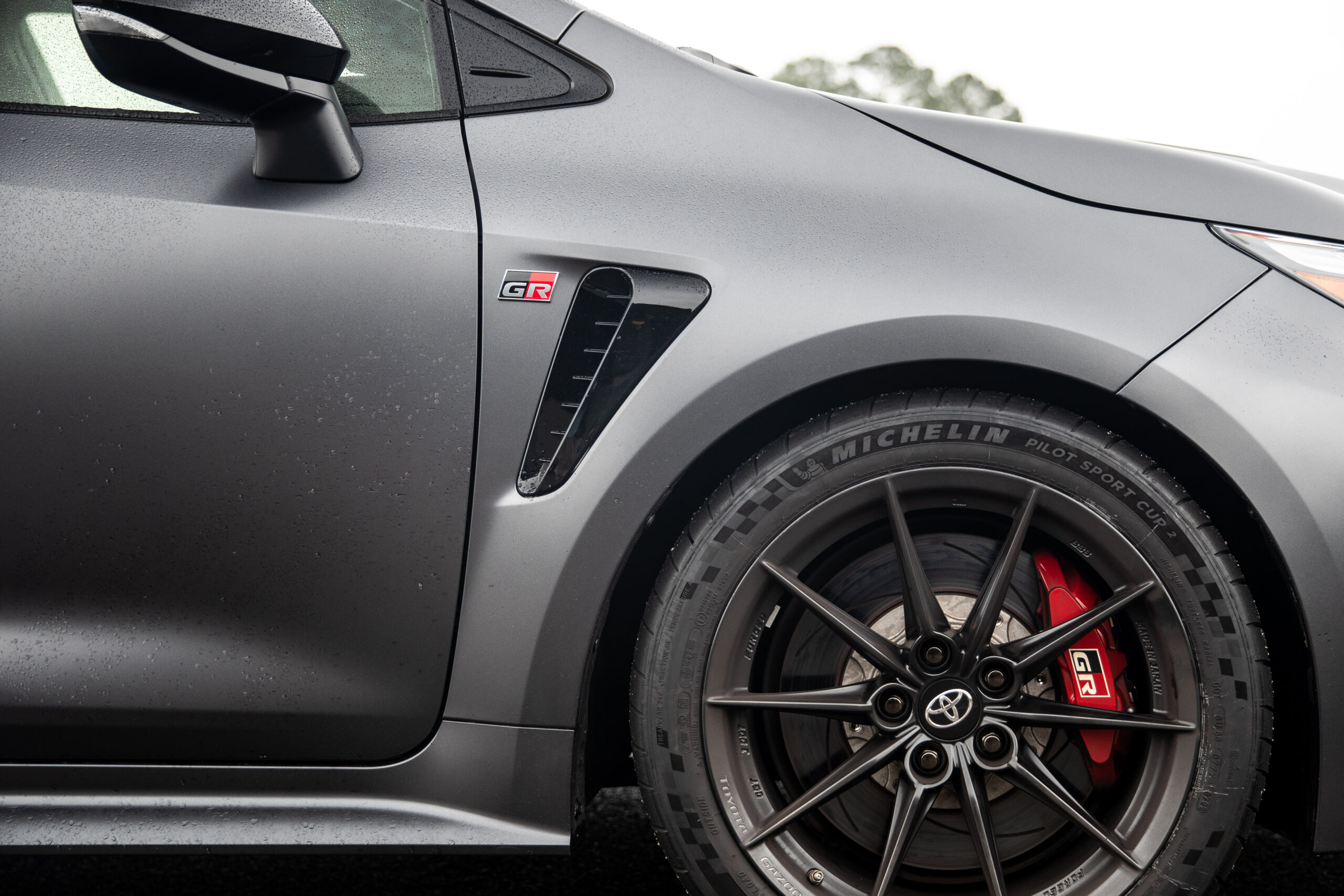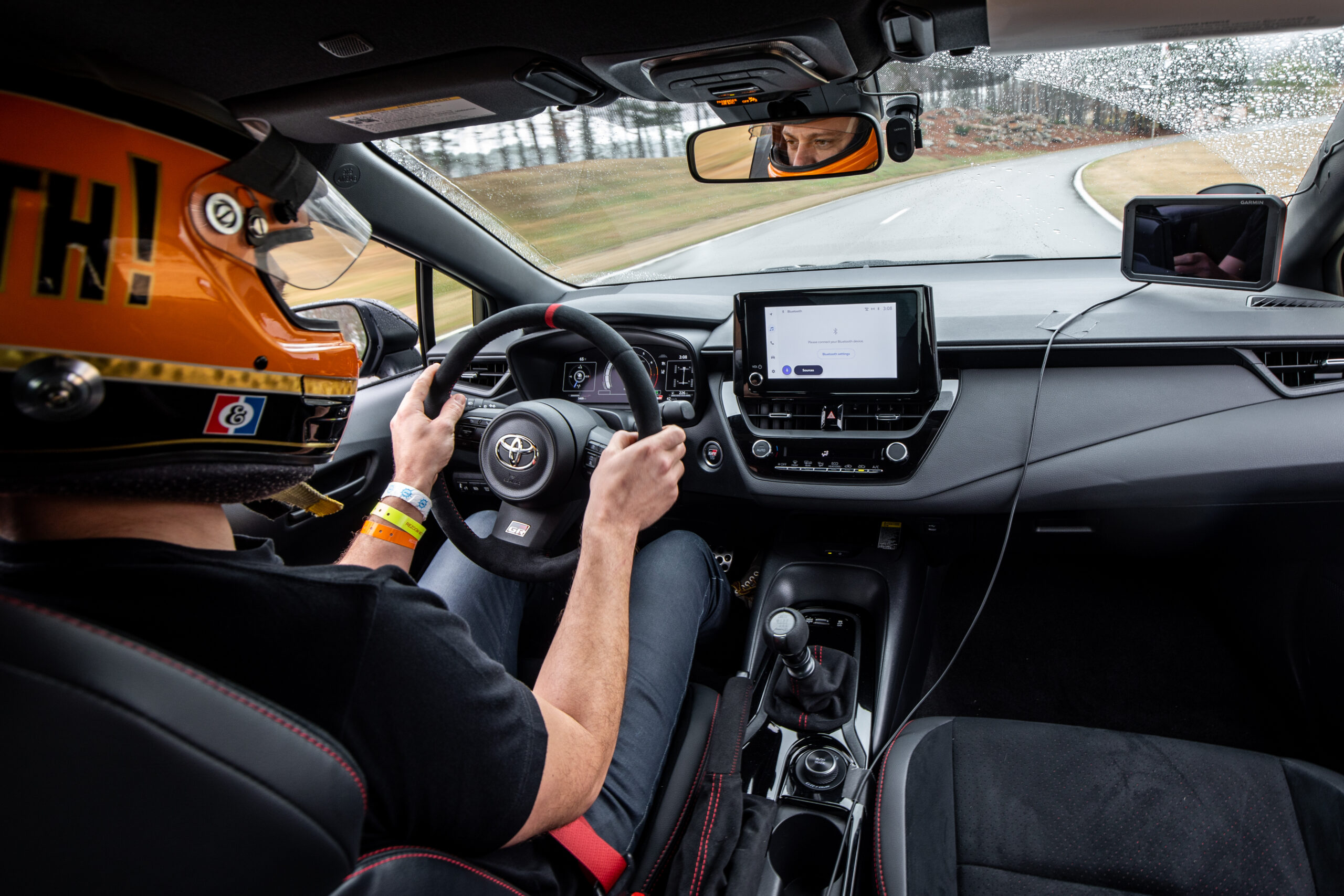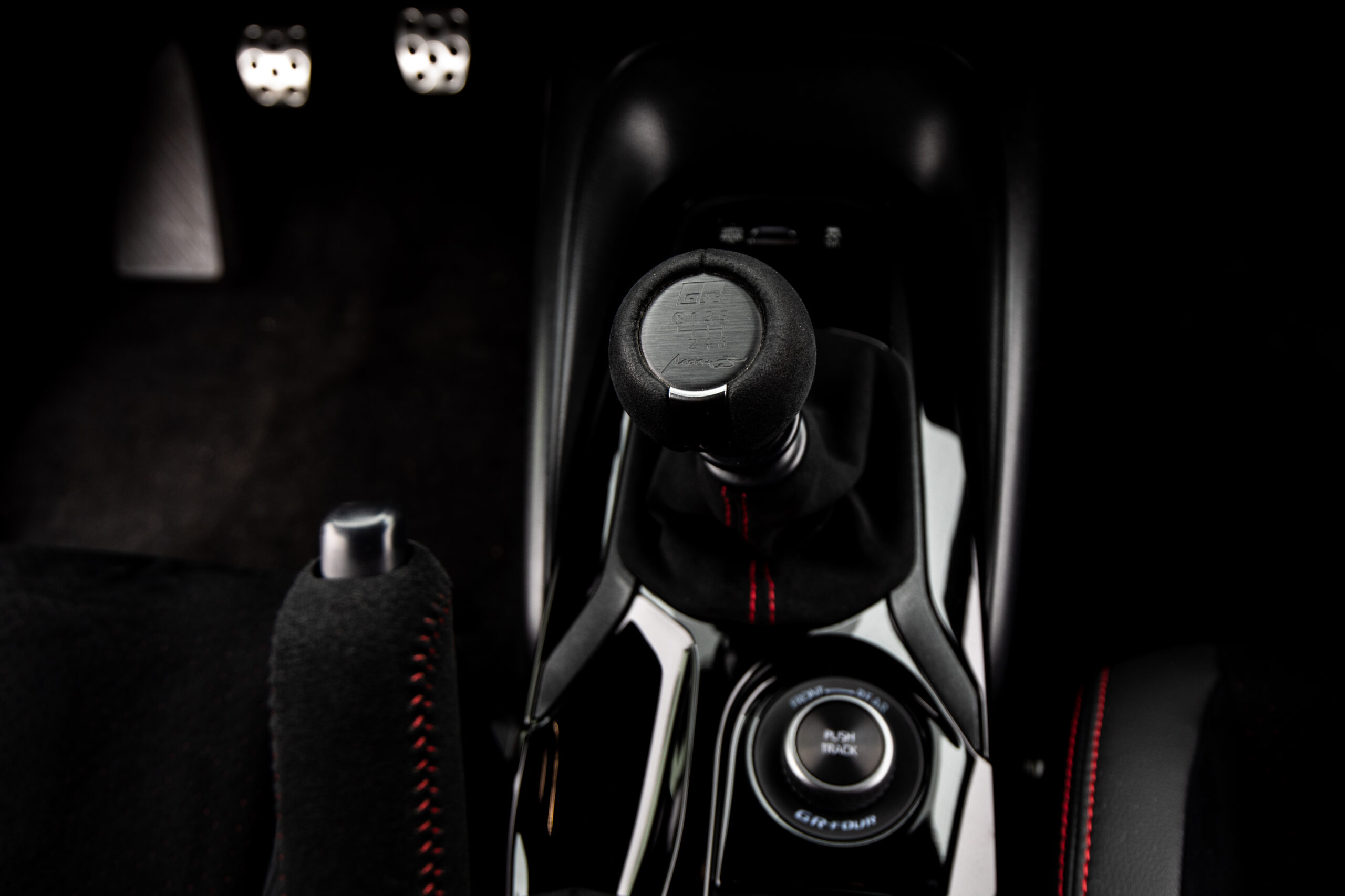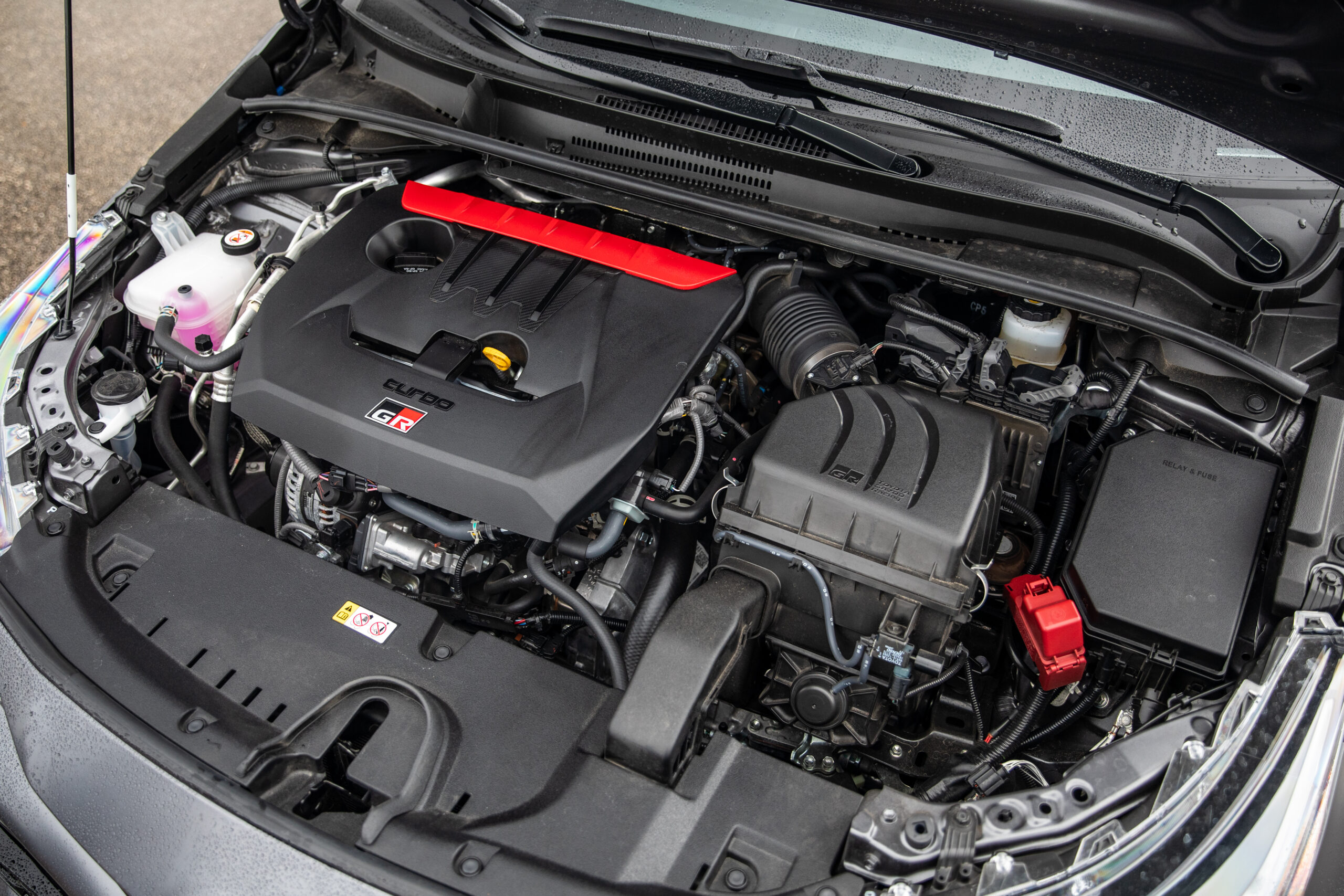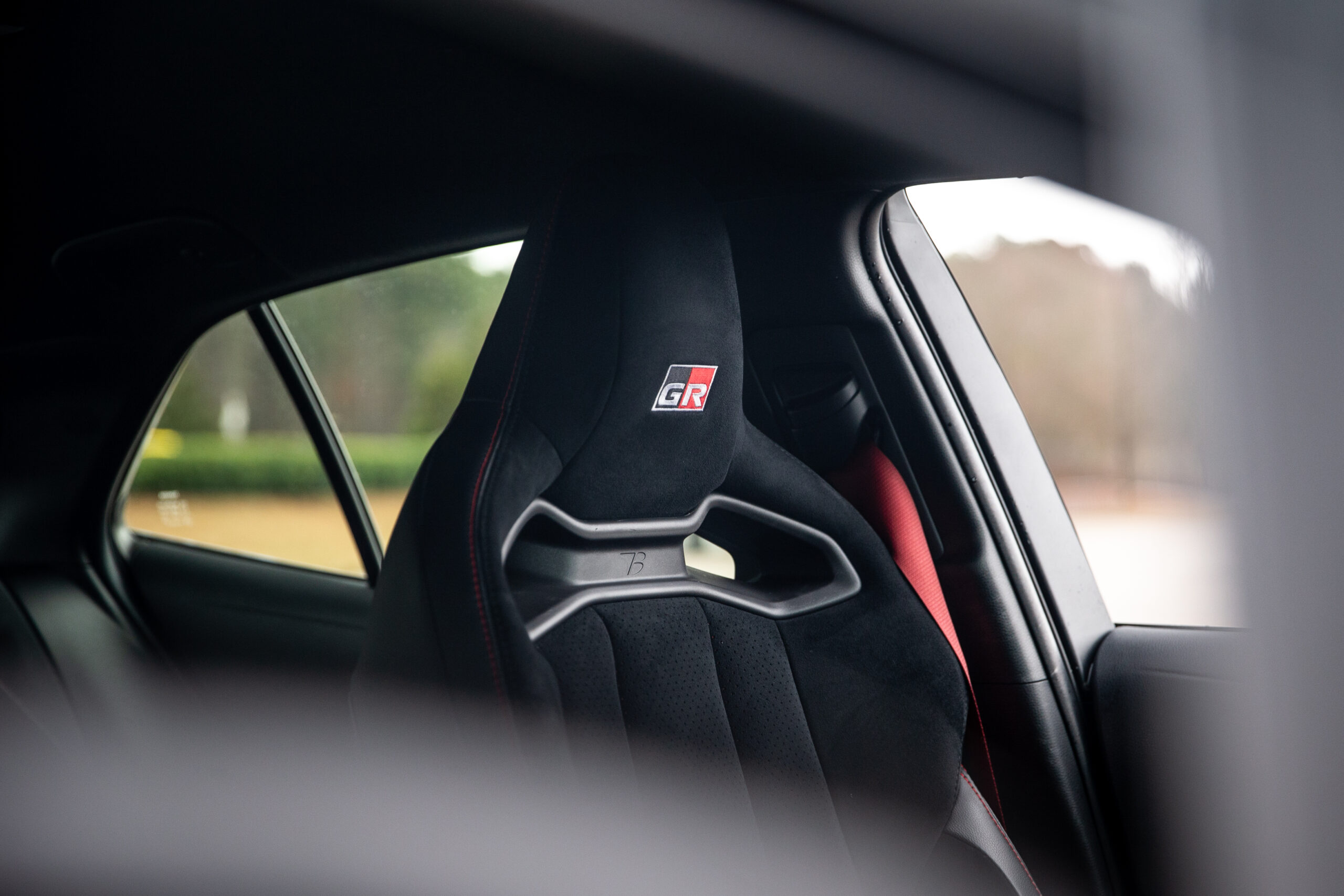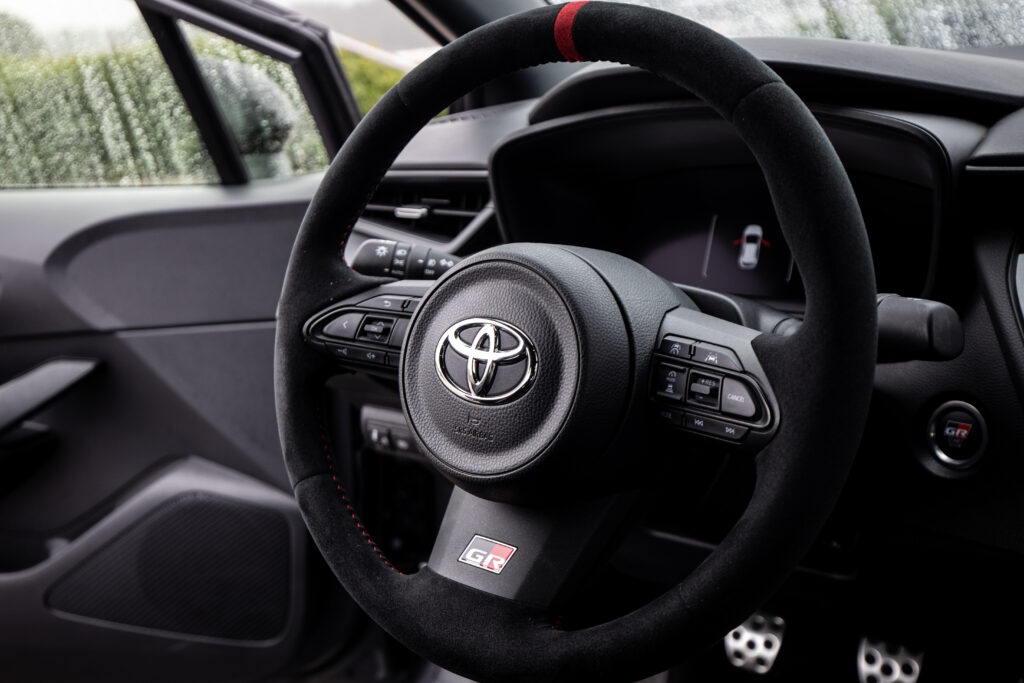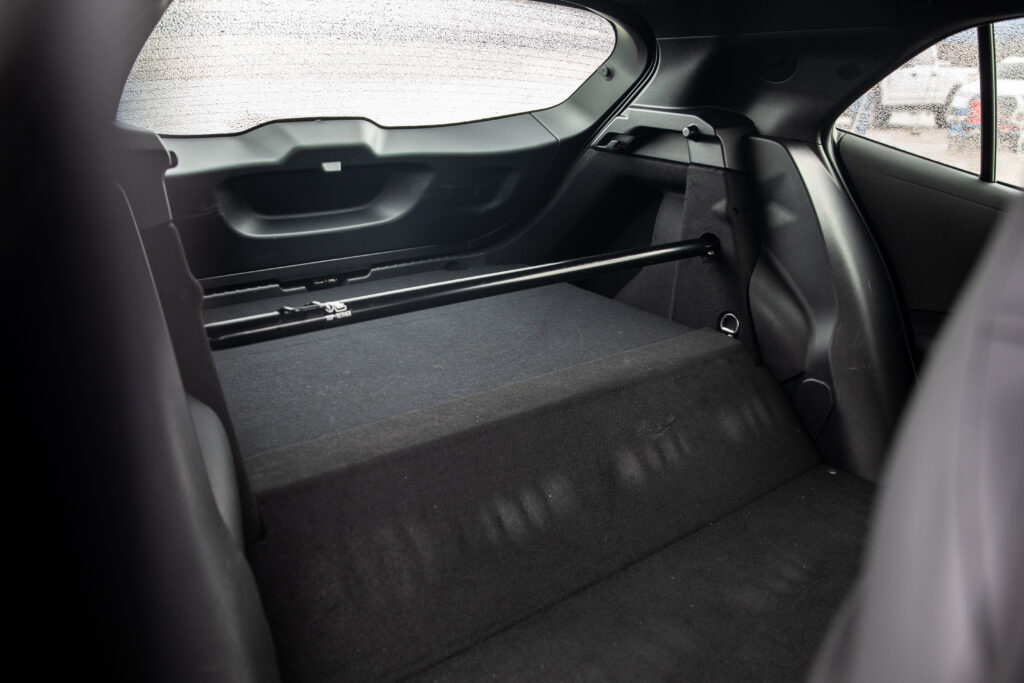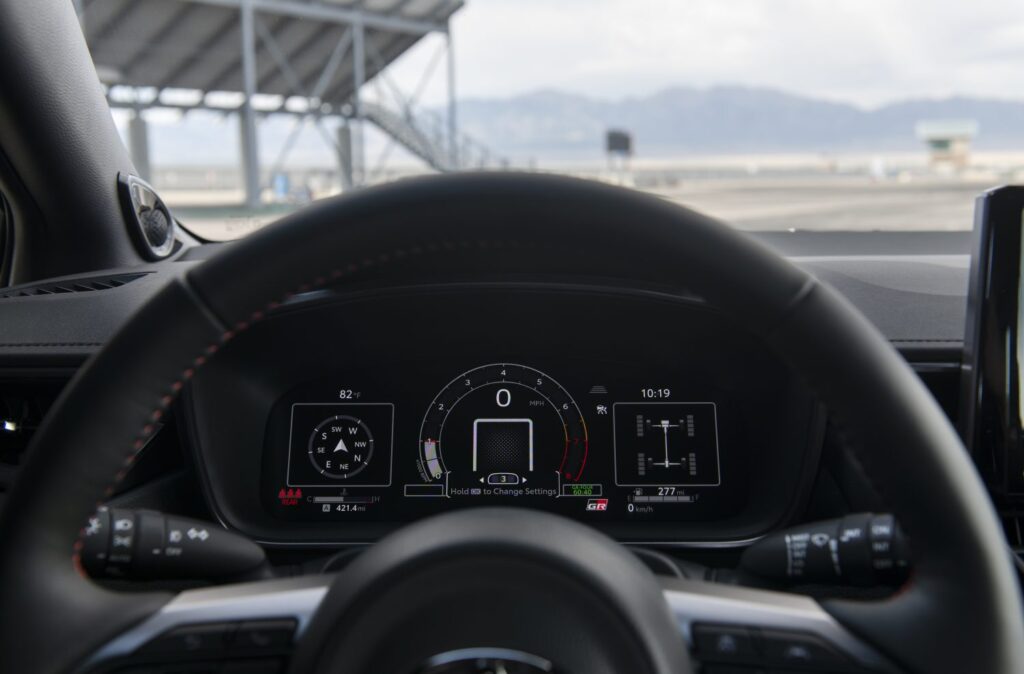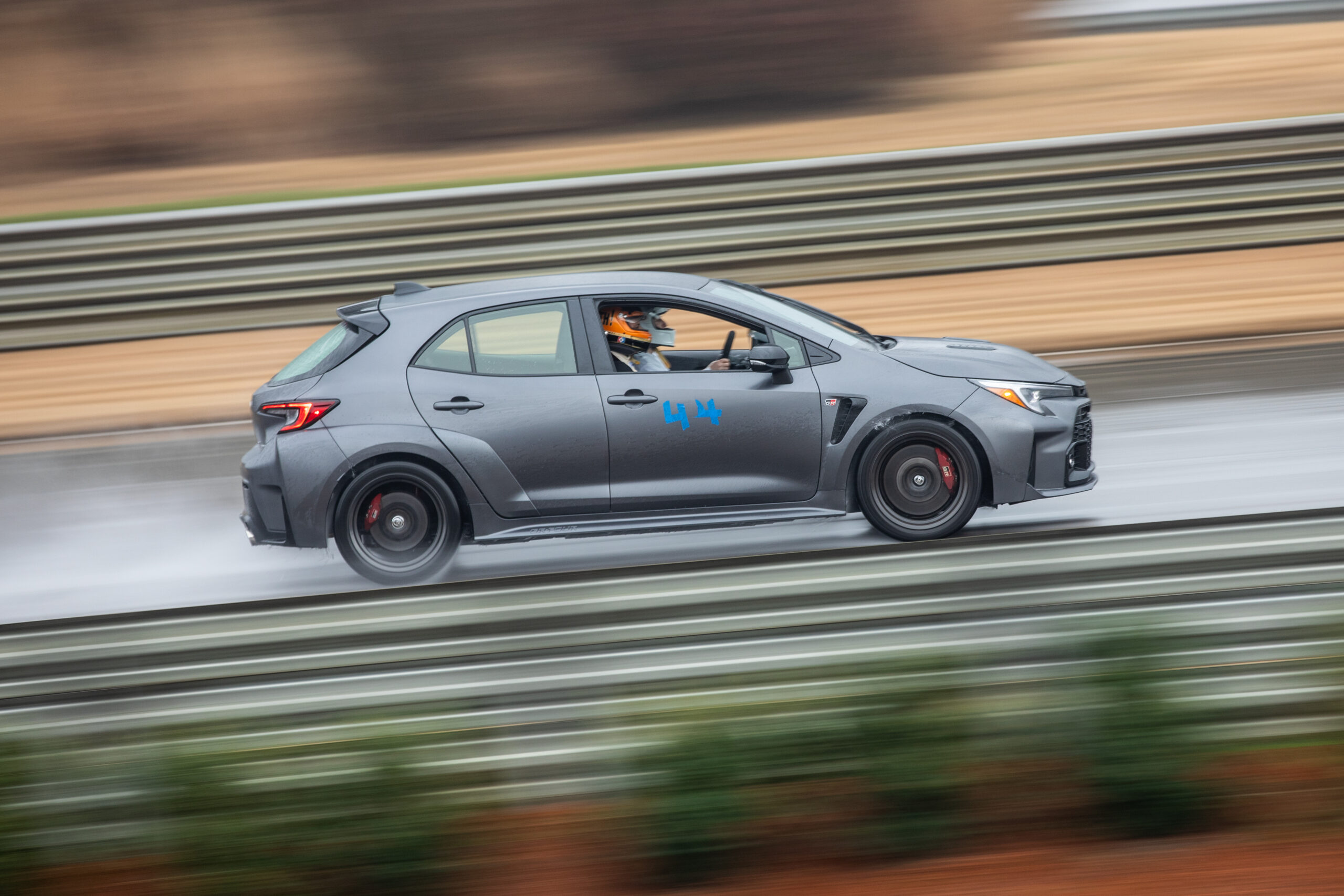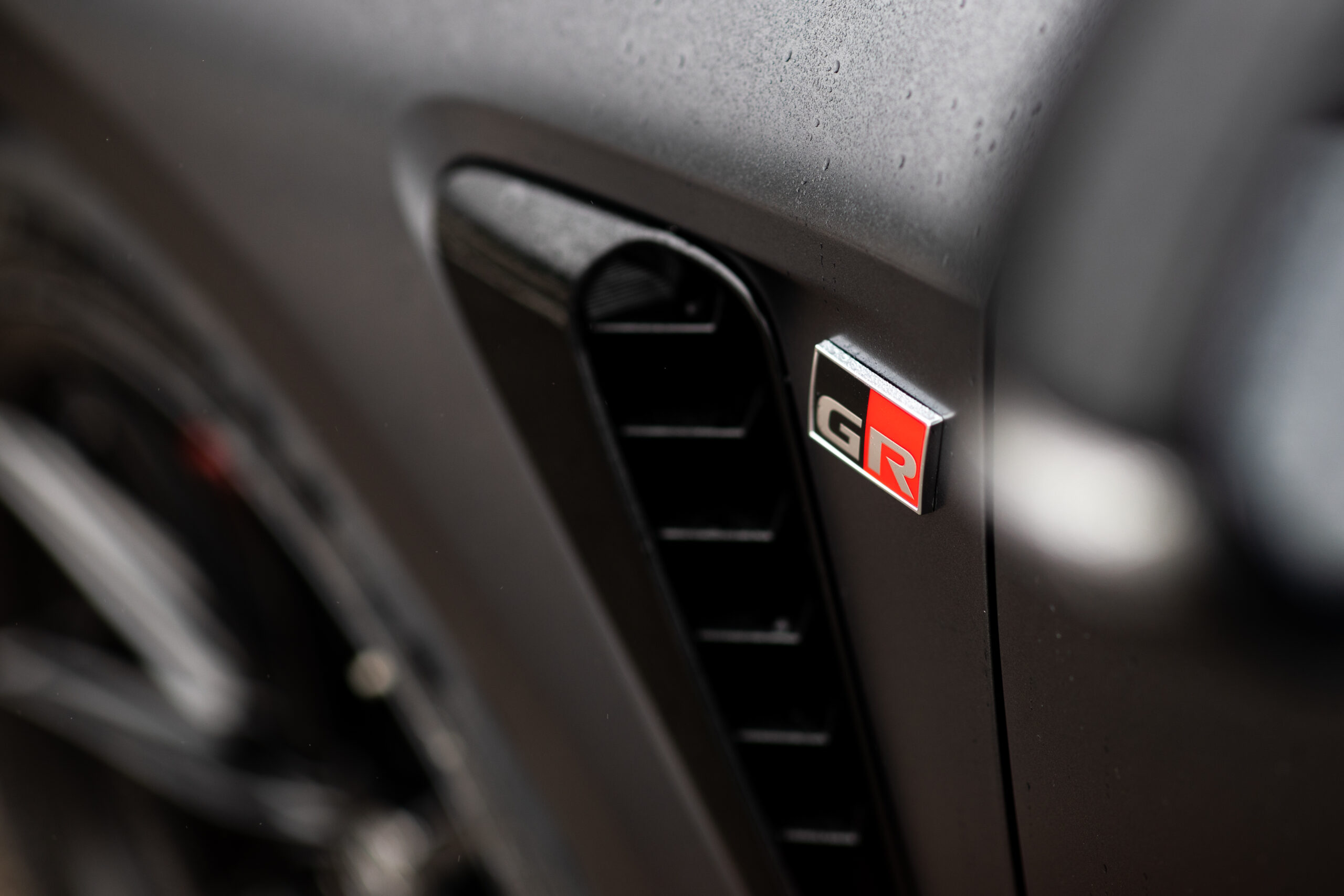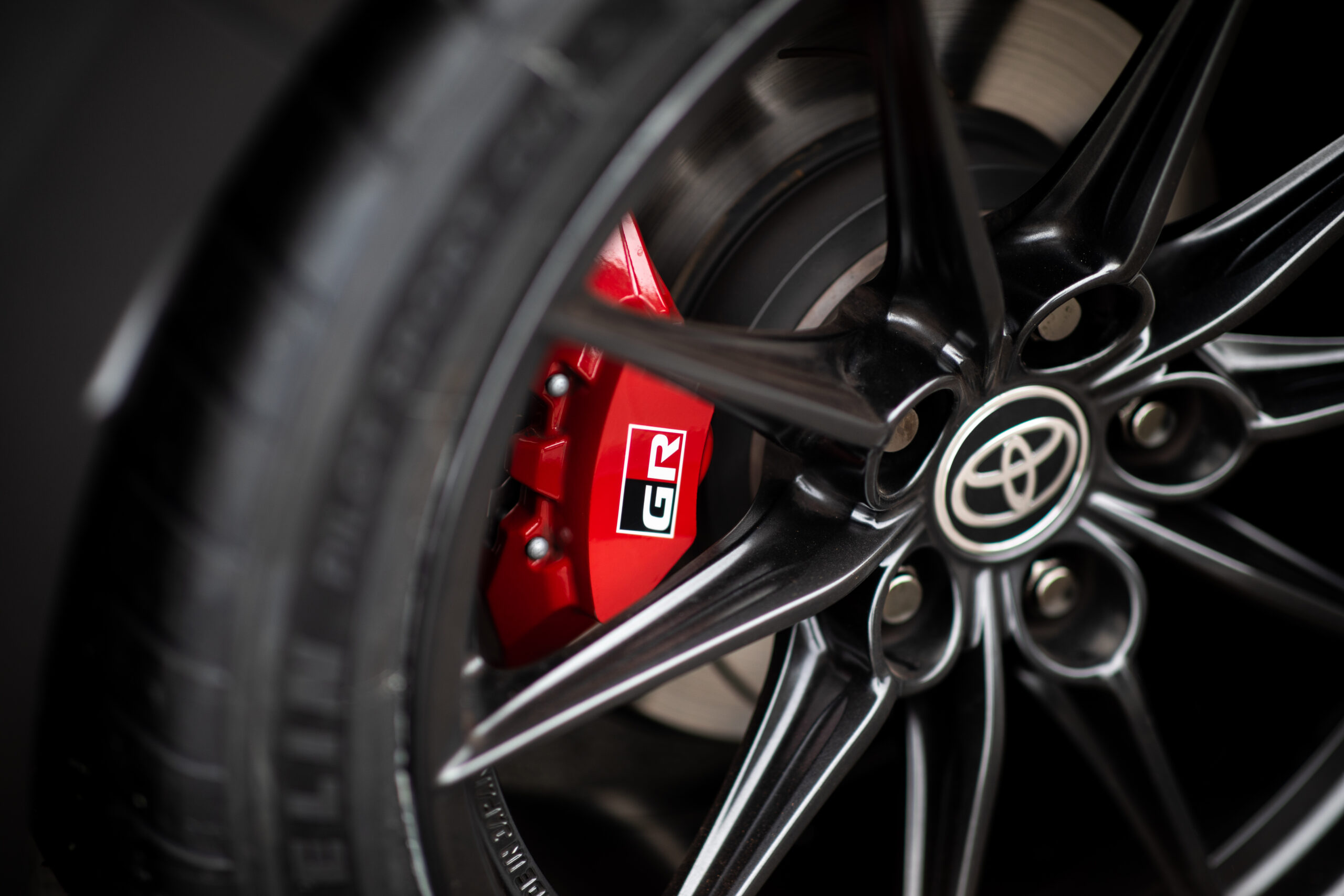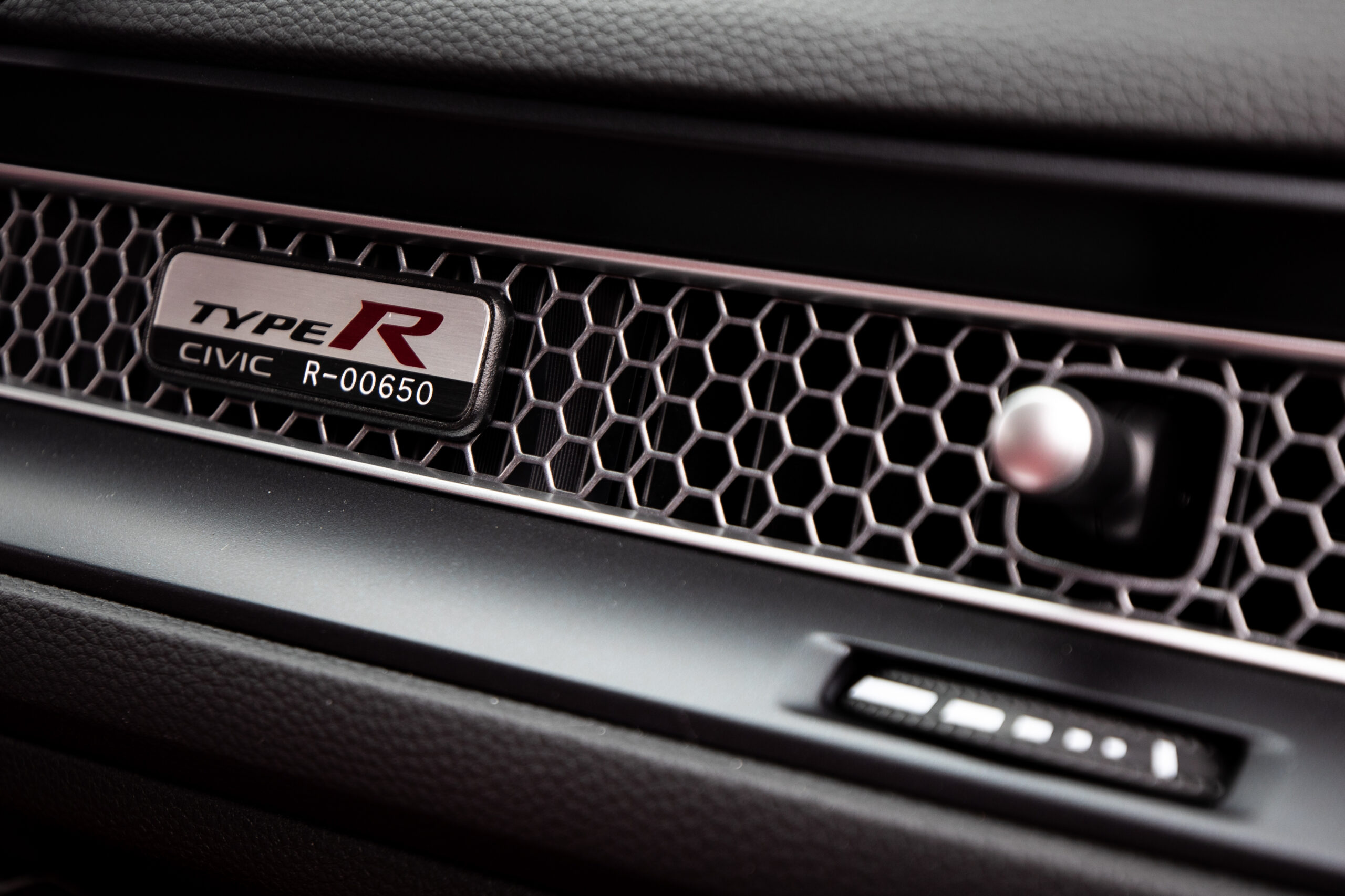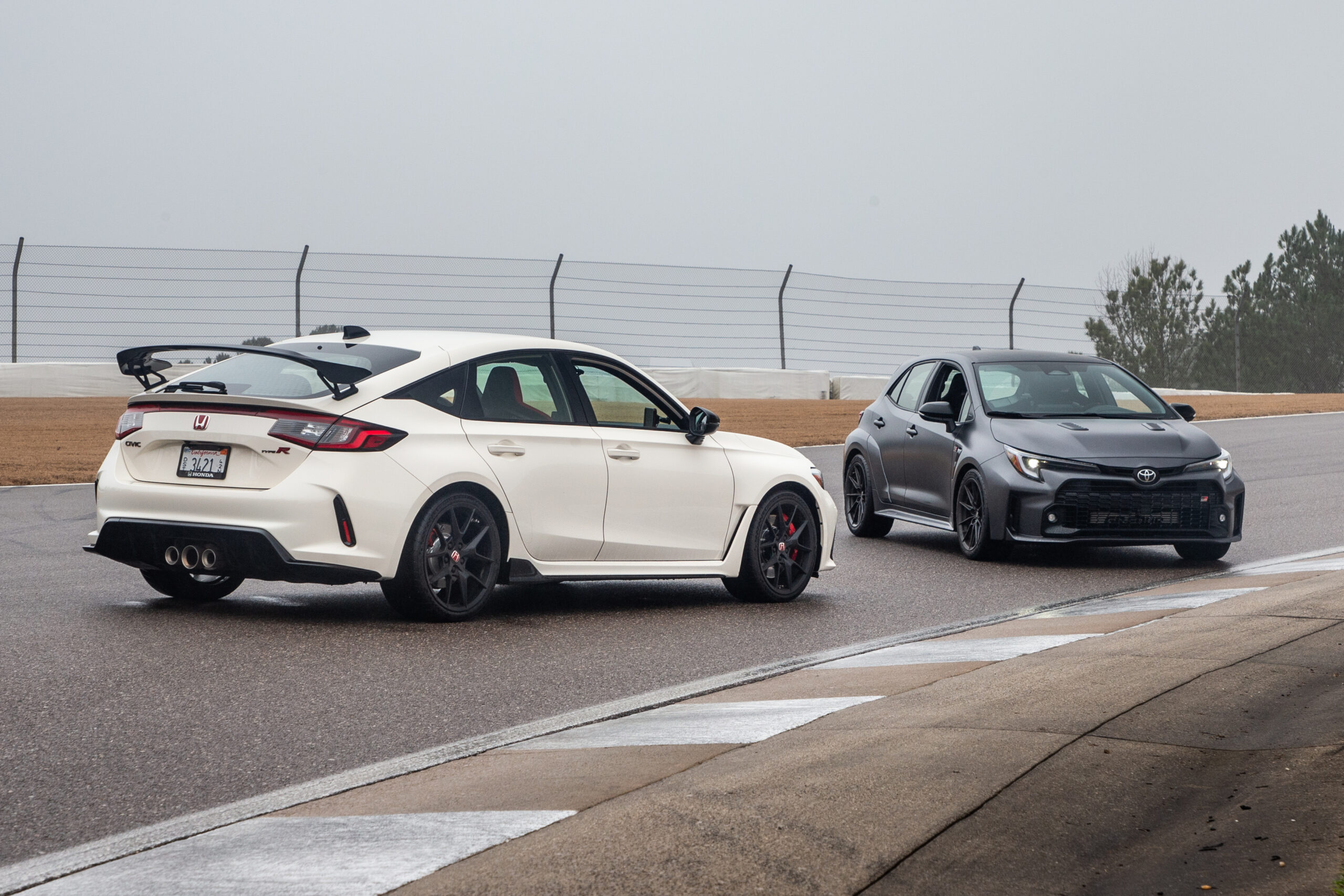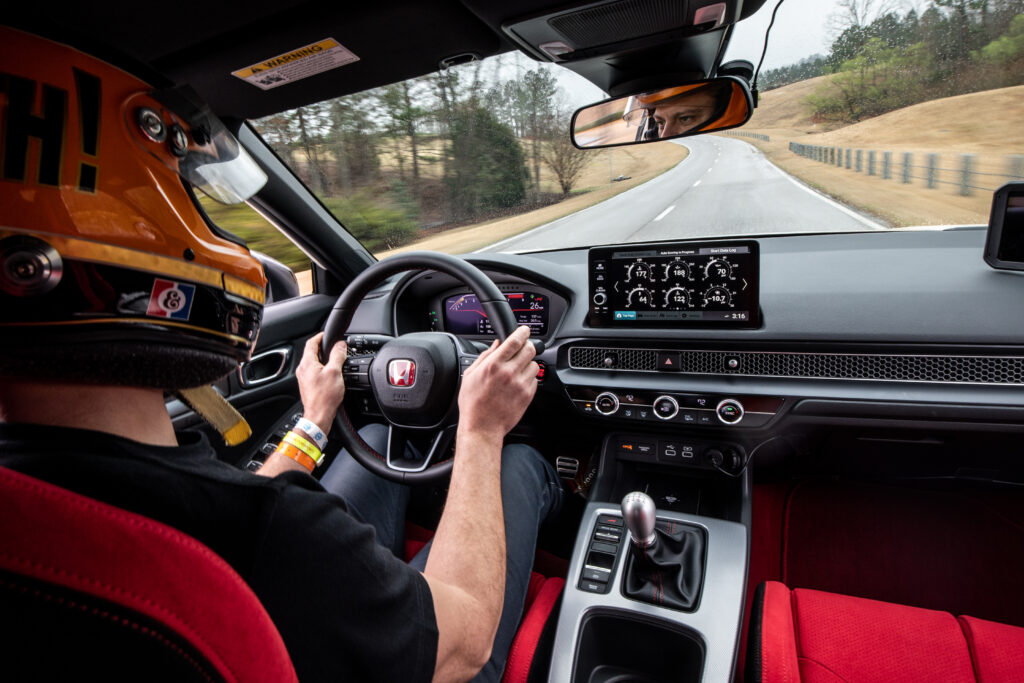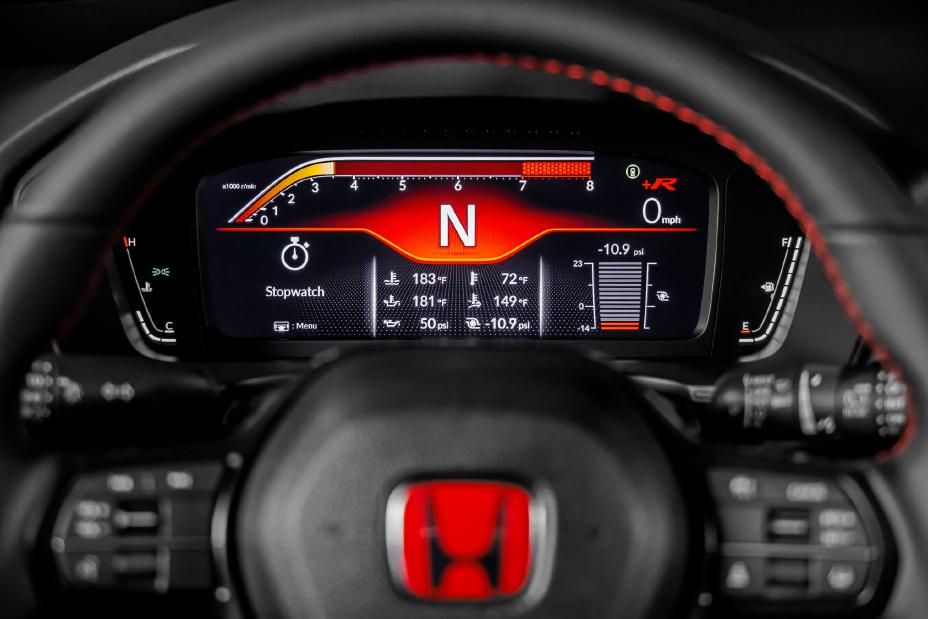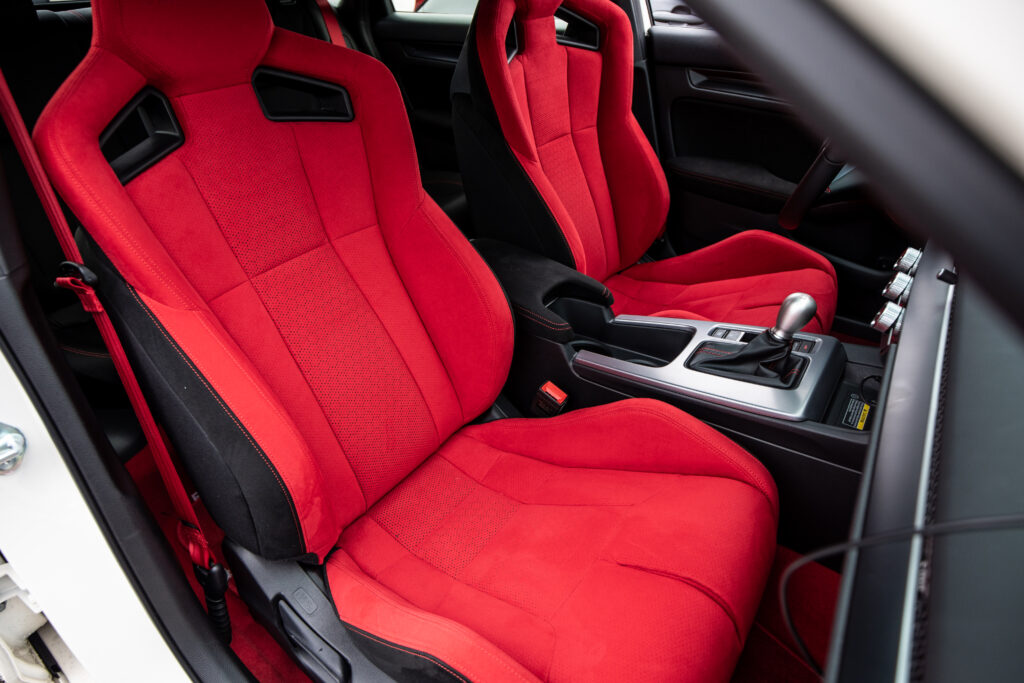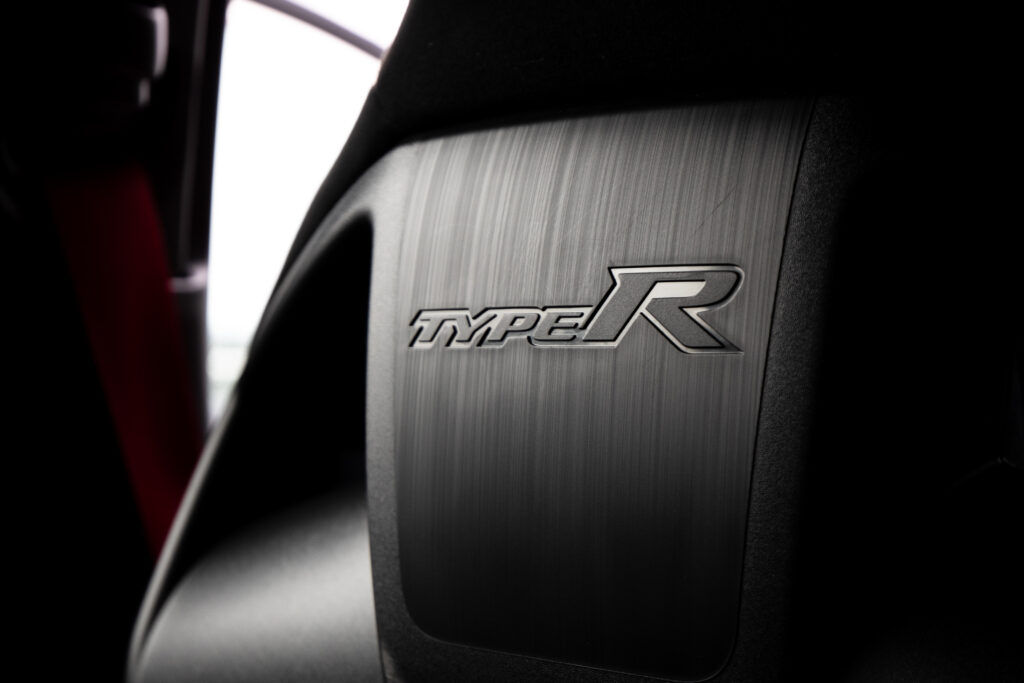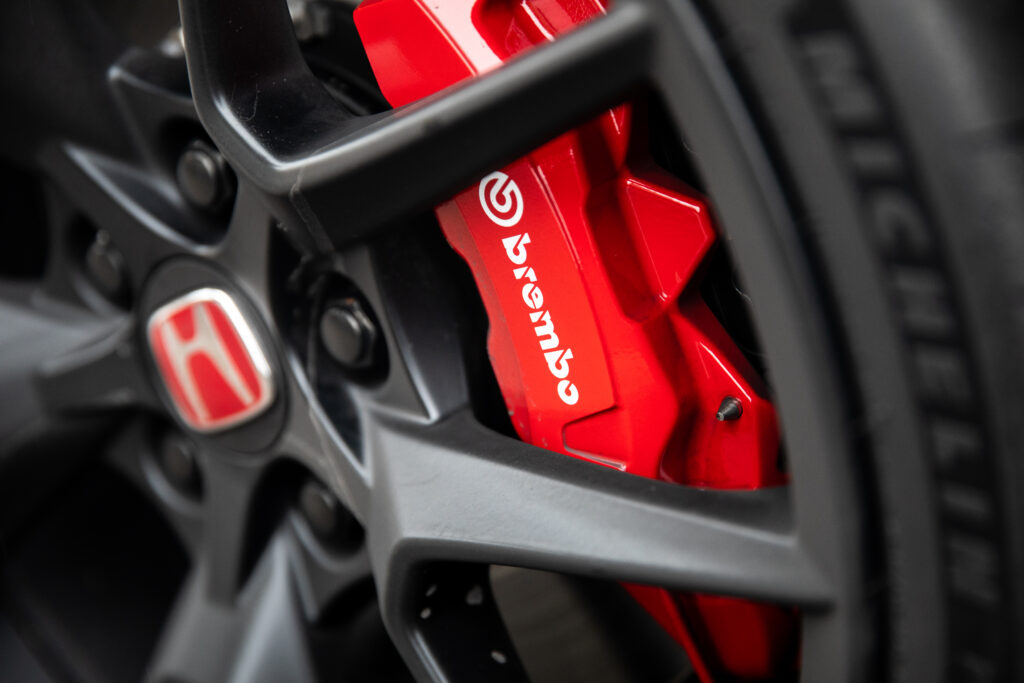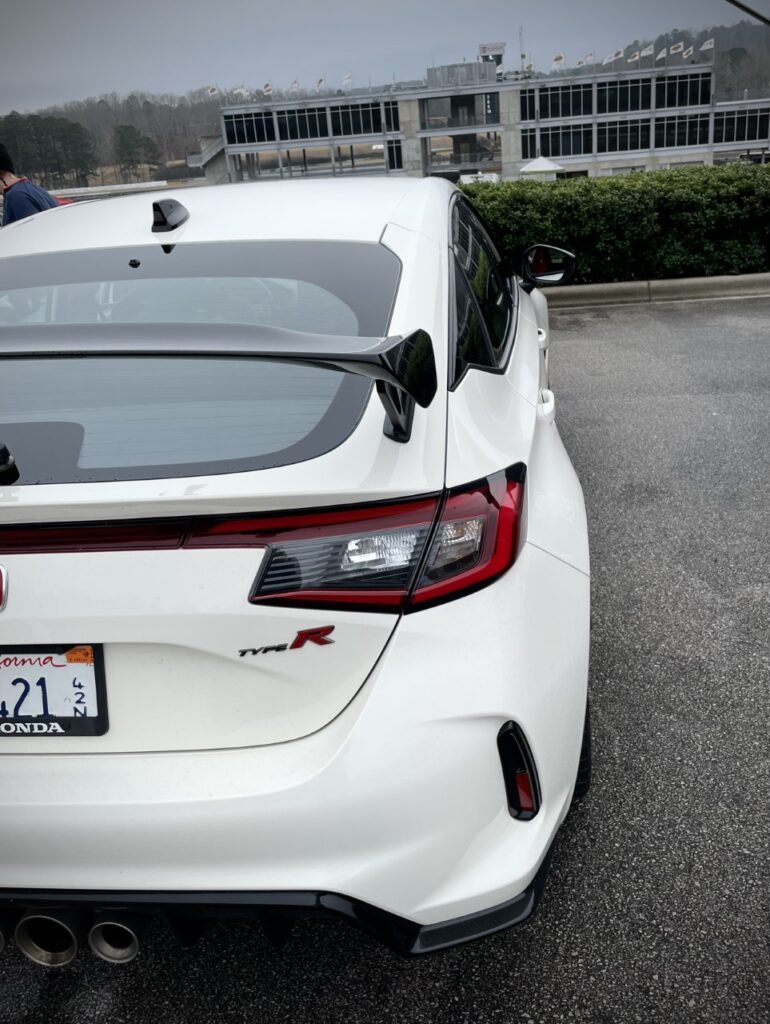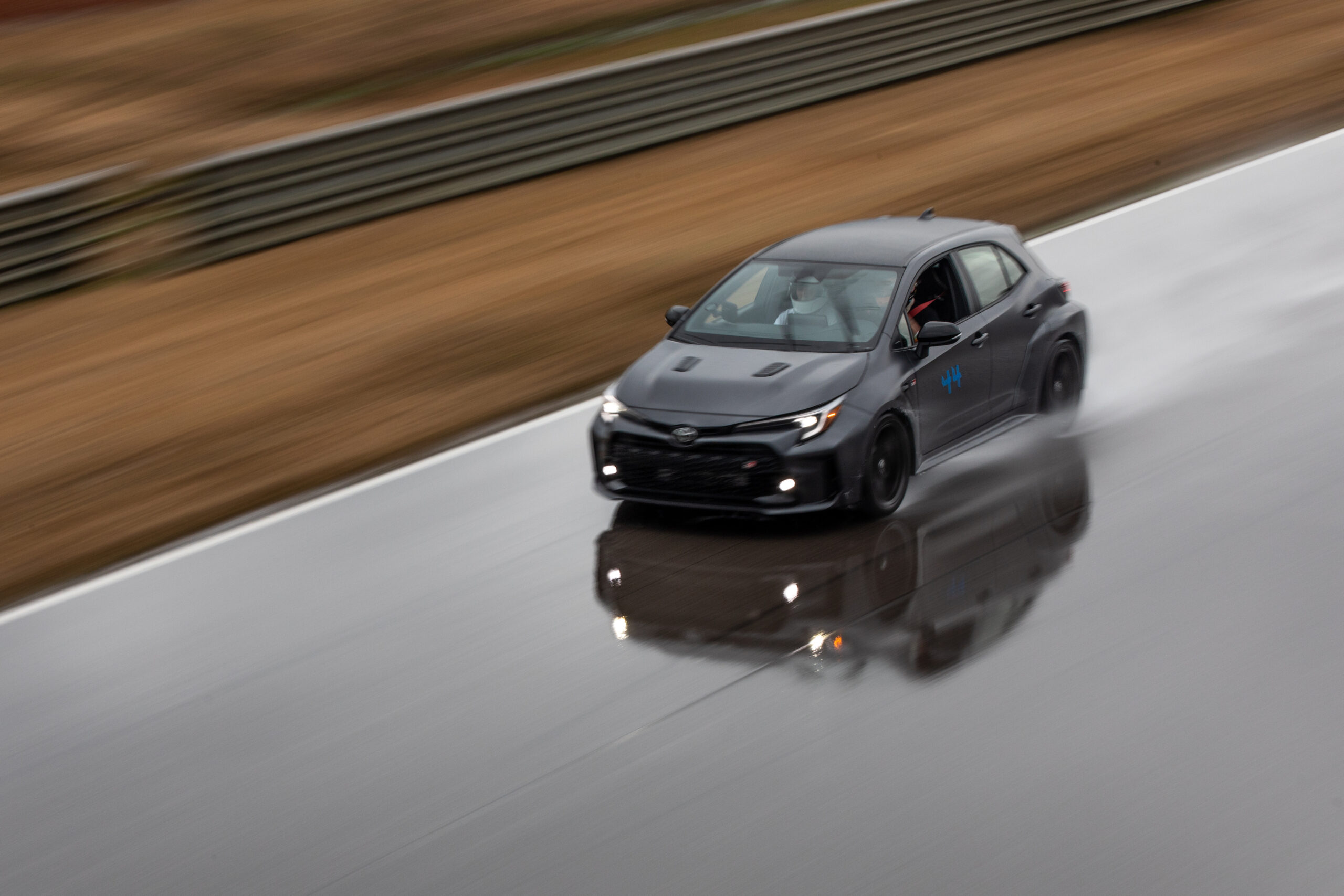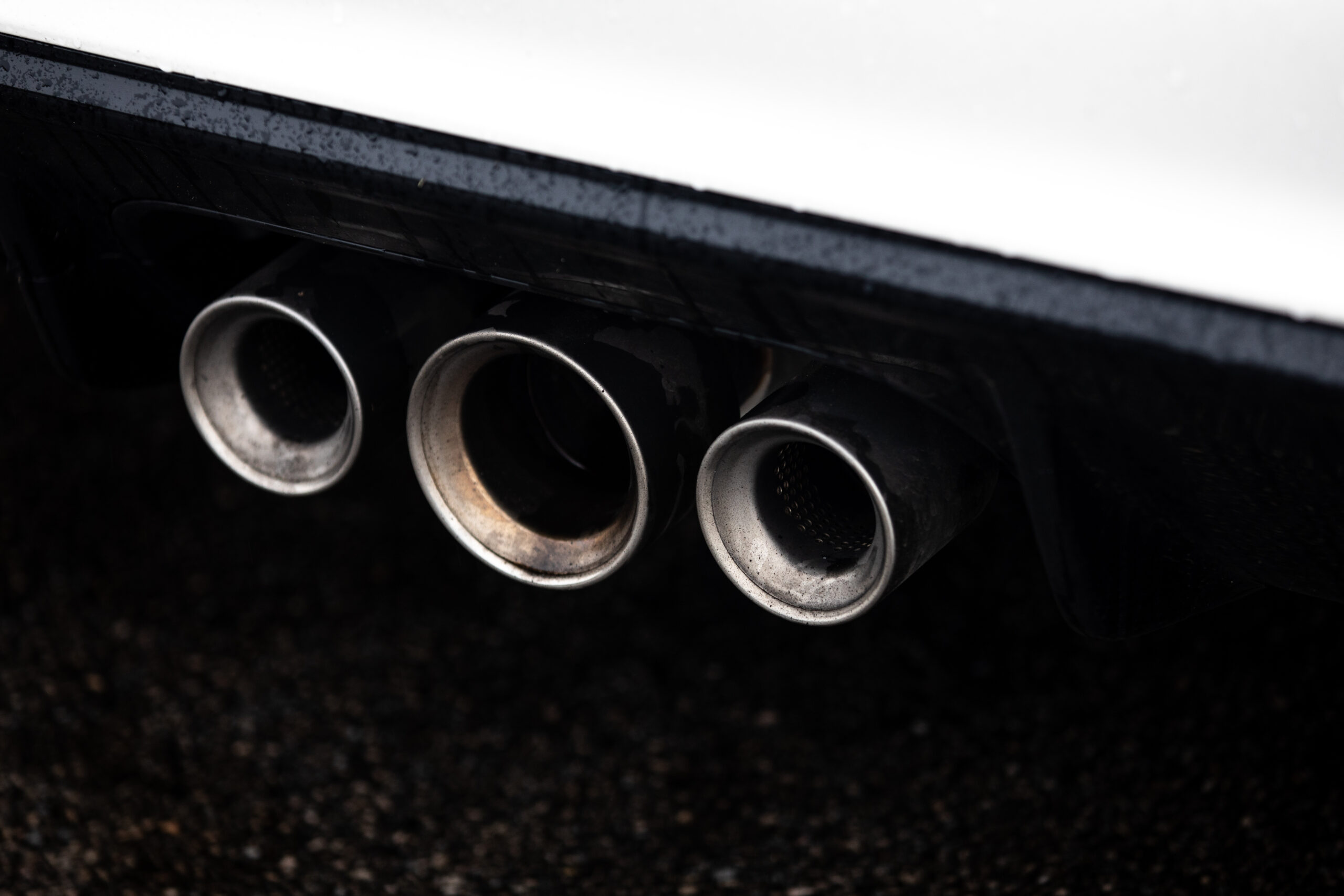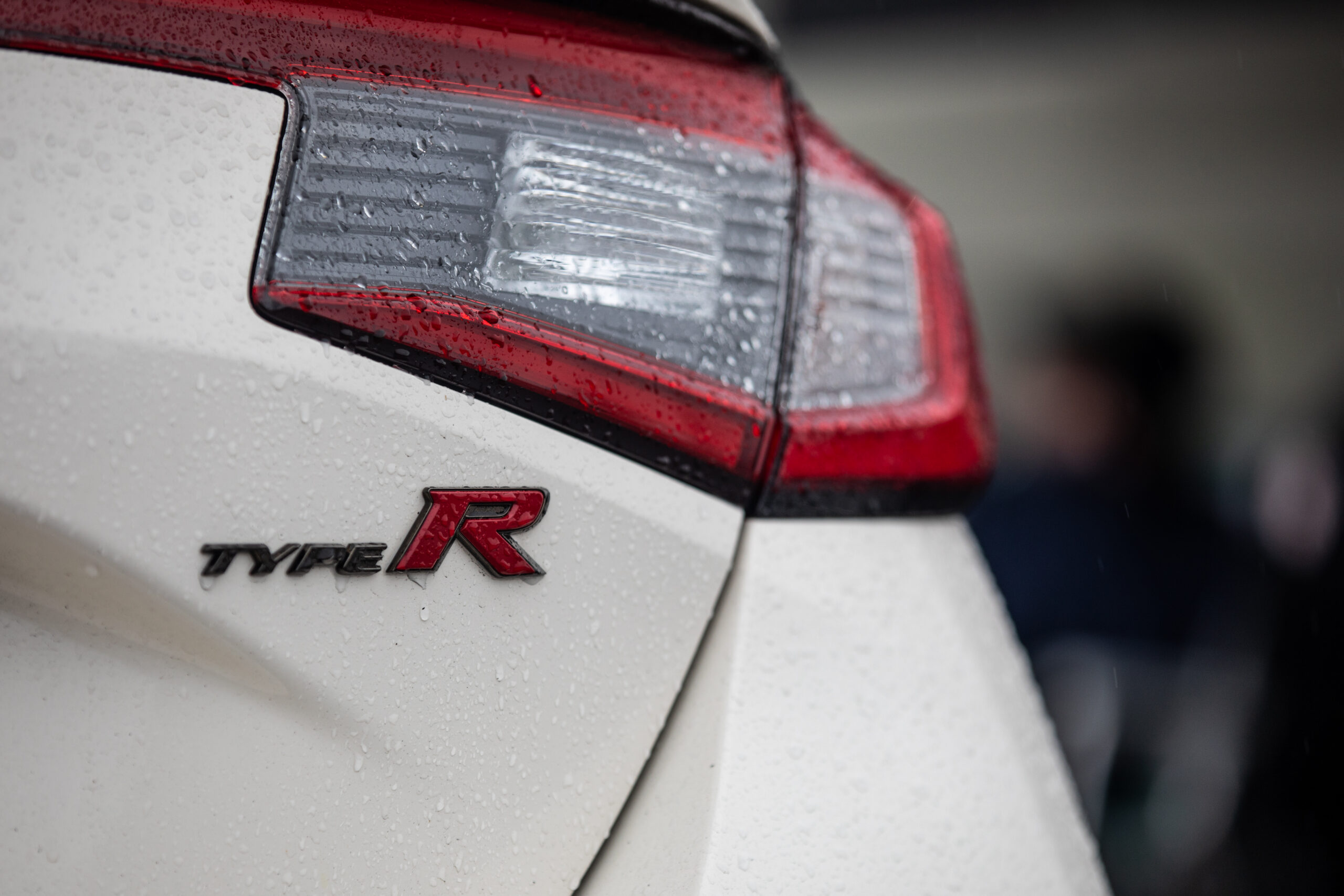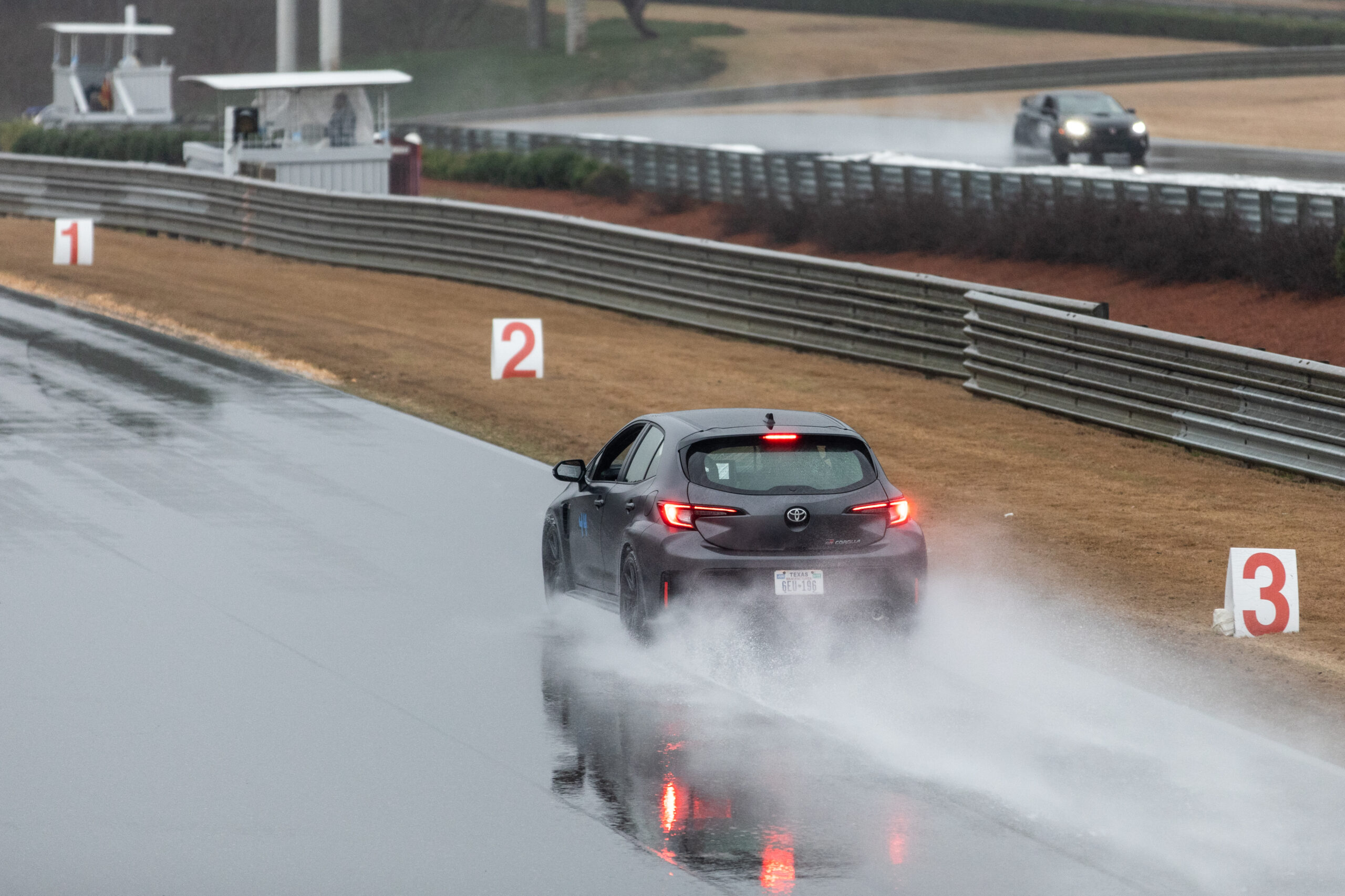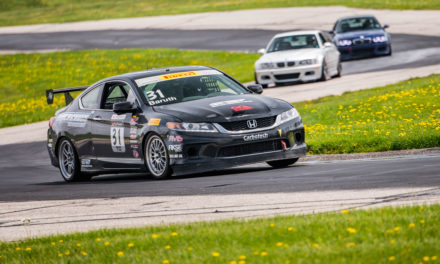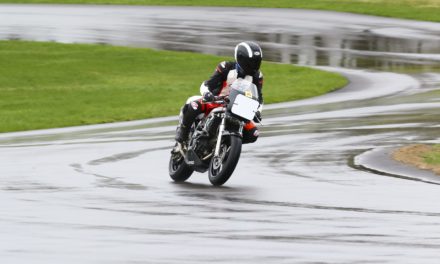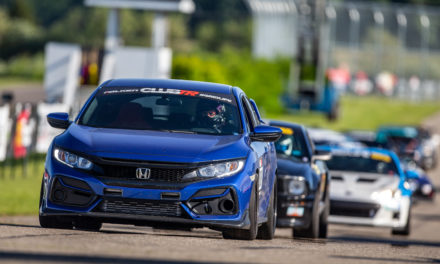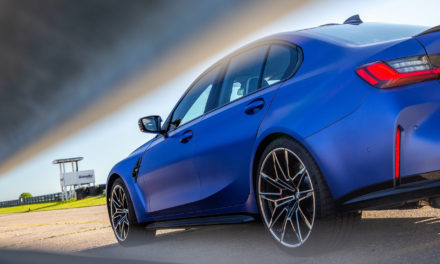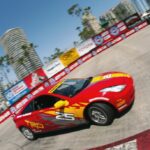In this corner, a 315-hp, family-car track star from Japan!
In that corner, a 300-hp, econohatch track star, also from Japan!
Honda asks Toyota to step outside! Which far-east street-fighter will come out on top in a back-alley brawl for the . . .
Nah. That’s not it.
If you haven’t noticed, Hagerty does more than review new cars. Yes, this company’s media division is staffed by veterans of Car and Driver and Road & Track, but our approach to comparison tests is different. We take a car to a closed course only when character or history demands it. We conduct such track tests not as battles, but out of love for the deeper dive. On that note, meet two demanders.
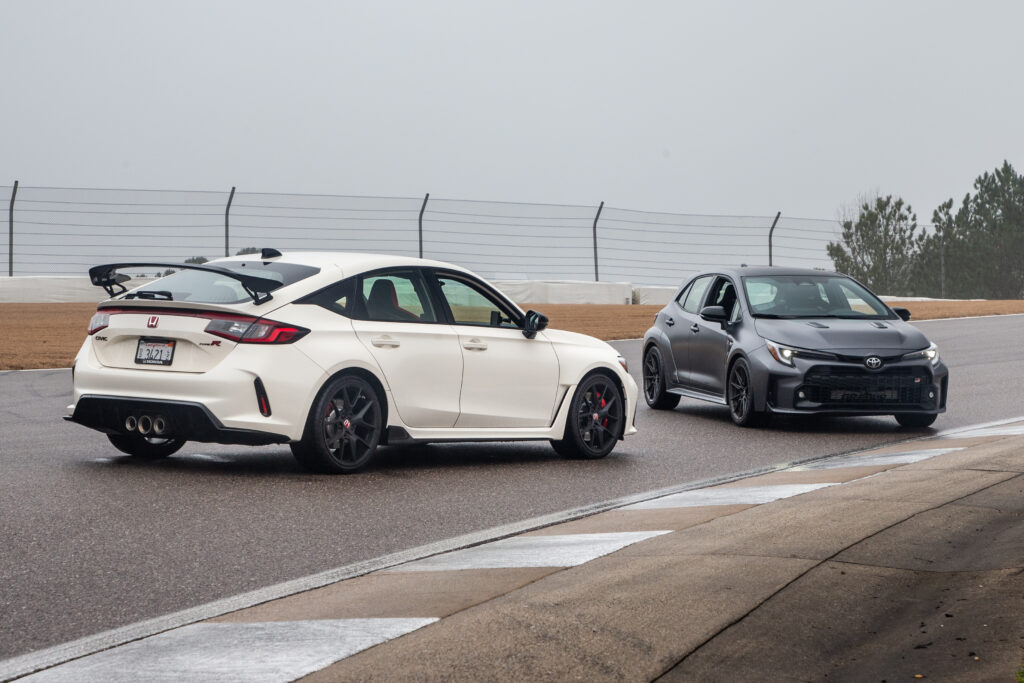
The white car is a 2023 Honda Civic Type R. The gray one is a 2023 Toyota Corolla GR. The Honda and Toyota are members of a dwindling species—economy cars tuned for the speed-freak die-hards. The 300-hp Corolla is a similar-think spinoff of Toyota’s smaller GR Yaris, a homologation special not sold here and designed for a World Rally Championship effort. The 315-hp Civic Type R is a flared-fender uprating of Honda’s 158-hp Civic hatch.
Each machine weighs around 3200 pounds and offers, as factory option, an 19-inch version of Michelin’s excellent Pilot Sport Cup 2 dual-purpose track tire. Both our test cars were so equipped. If you’re not familiar, the Cup 2 is a factory fit on the Porsche 911 GT3 RS and the Chevrolet Corvette Z06. This is the most well-rounded street/track tire that money can buy. More important, it does not paper over suspension flaws or make a car look better than it is.
The Corolla was a one-of-200 Morizo edition; for $14,000 over the base GR Core model, this variant offers wider rubber, shorter gearing, Torsen limited-slip differentials front and rear, a more aggressively tuned suspension, 22 additional lb-ft of torque, and a 100-pound diet. It ships minus rear-window regulators, rear-door speakers, a rear wiper, and a second row of seats.
Before we hit the nitty-gritty, two quick notes on method:
1. Testing occurred during a two-day public lapping event at Alabama’s greatest roller coaster, the 2.36-mile Barber Motorsports Park.
Dozens of laps—in the dry, in a blinding downpour, and everywhere in between.
2. We did not chase data or lap times.
Publishable lap times and data require a degree of repeatability and focus unavailable in our test environment. That said, both the Honda and the Toyota were fitted with a Garmin Catalyst, a consumer-grade digital coach and logger, primarily to ensure fair treatment. (After we published our first Catalyst review last year, Garmin offered one to Hagerty free of charge. We declined but found the device impressive enough to buy two for company use.)
Testing was split between two drivers: Your narrator, an experienced amateur racer and longtime vehicle tester, took lead. Site director and Executive Editor Eric Weiner, a track-day enthusiast of moderate pace, brought the everyman perspective. The goal was to suss how these cars would present, on a closed course, for real people.
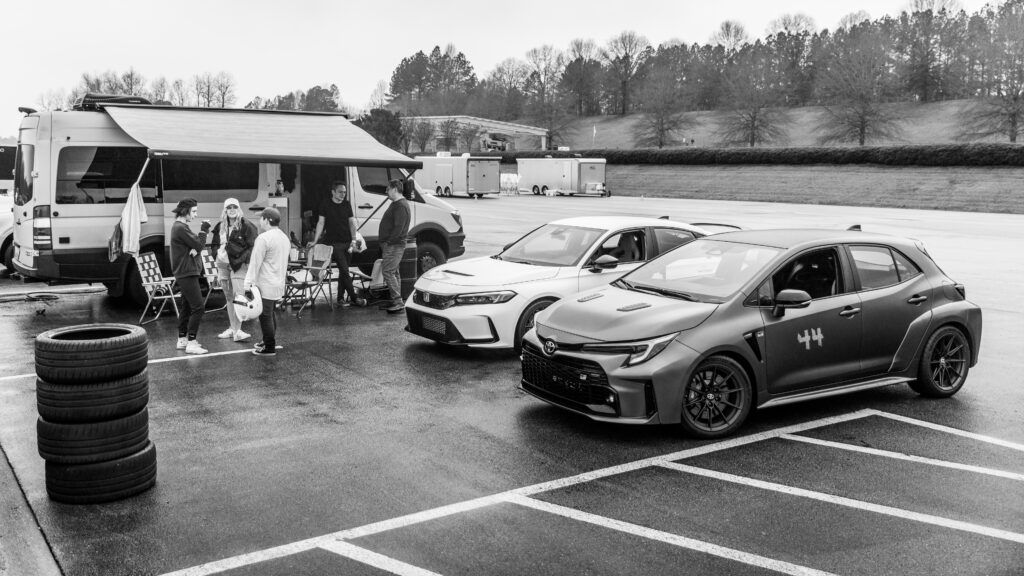
The paddock at Barber. Note impossibly serious last-minute public-track-day door numbers. (Masking tape.)
In other words, with these cars, this test is only part of the story. A track is not a road; a public track day is not a private magazine test; the Morizo is not the base, open-diff G-Rolla; those amazing Michelins offer remarkable grip and life in ideal conditions but are mostly unsuited for everyday use. They are also less than ideal—albeit capable and progressive—in the wet.
Maybe that seems like too many caveats. We share them only because your emails and comments have told us you want to know.
The cars were fantastic. Let’s dive in.
***
2023 Toyota GR Corolla Morizo
Meet the $51,000 Toyota Corolla. It makes 300 hp from just three cylinders. It has a turbocharger and four driven wheels. Those fender flares house fat (245-width) and thin (40-section) 19-inch tires. Top speed is electronically limited to 143 mph. A six-speed manual is the only available transmission.
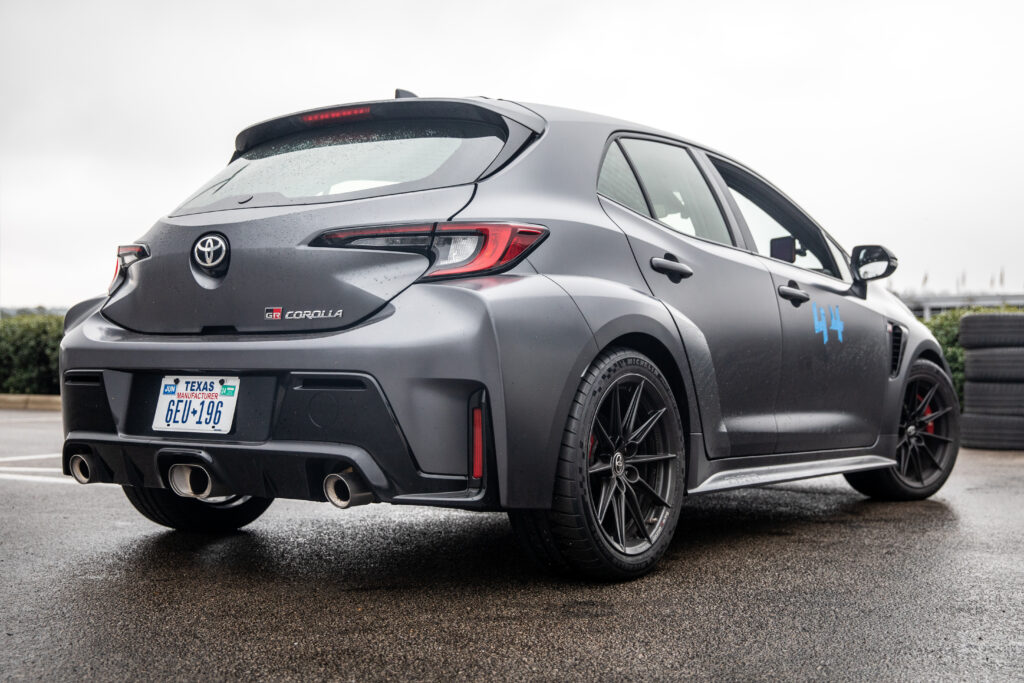
If you happen to park this strange little rugrat at a race track or within sight of car people, you will certainly get approached and questioned, as we did:
I heard it was built for rally. It works at a track day?
Totally.
Forty grand for a Corolla!
But with the heart of, like, a rabid chihuahua.
Is the Type R faster?
Probably, at most tracks, as long as it’s not raining or snowy, but then, you know, the Civic doesn’t have bodywork like Blinky the Three-Eyed Fish from The Simpsons, nor does it spit gargly Porsche-like noise on a cold start. And we haven’t even talked about how the Toyota just funk-hustles half-backward into a fast downhill.
I love it! Like mad science.
Right?
- On Barber’s perimeter roads, making Serious Fast Face at 30 mph.
- Morizo shift knob, driveline switch.
A base 2023 Corolla SE five-door costs $24,060. That car’s suspension has some hoots to it, but the rest is nothing special. Dead steering. The engine, a 169-hp four, is dull as a lead pipe and 20 horses shy of Just Enough.

Where three-pot dreams are made.
WRC-tinted hot-rodding changes everything. The base Corolla makes do without the GR’s nine extra feet of rigidity-adding structural adhesive. Or its extra floor bracing. Or its 349 additional body spot welds. Most of all, you cannot climb into a base Corolla and use a console rotary switch to adjust the front-rear torque split of the car’s two differentials and clutched center driveline coupler.
Because the base Corolla, being a front-drive hatch, does not have those parts.
Boo hiss, really, but then, 23 grand is only 23 grand, and we all have to serve somebody.
“This is an utterly ridiculous pop rock of a thing that I can’t believe we even get to buy here. And from Toyota, of all places! It’s the kind of thing Subaru would do, and then only at low spec and for stupid money.”
—Eric Weiner, Hagerty Media Executive Editor

The duration of that cam lobe! That delightful little block!
The G-Rolla (for that is what we are calling it) uses the basic driveline engineered for the GR Yaris, a subcompact not sold in the U.S. The Corolla is 32 hp stronger; credit not just the added boost and intake tweaks but the Toyota’s desire to minimize performance difference between the golf-cart-sized Yaris (2800 pounds, 157 inches long) and the larger Corolla (the aforementioned 3200 pounds, 173 inches).
That full-time all-wheel-drive system, Toyota says, was simply whipped up, clean-sheet, to suit the needs of the Yaris when in green-flag privateer hands. It is not related to any other production Toyota hardware.
How unlikely, in the current year, for this strange little Blinky-the-rally-fish to meet America.
- Tiddler under plastic.
- Seatback harness holes you probably won’t use but will enjoy looking at anyway.
If you want to like a machine like this, the downsides won’t matter. But they do exist.
The high-backed, heavily bolstered sport seats are comfy and decent, but the Honda’s similar chairs are more supportive. The Toyota’s cockpit seems darker, its plastics harder and more suggestive of low cost. Road and tire noise are substantial, and the ride can be flinty.
That little turbo-three is special, with a wallop of torque across the top third of the tach and fun midrange lag, but compared to the rest of the car, it can seem too quiet and reserved, often inaudible at speed with the windows down.
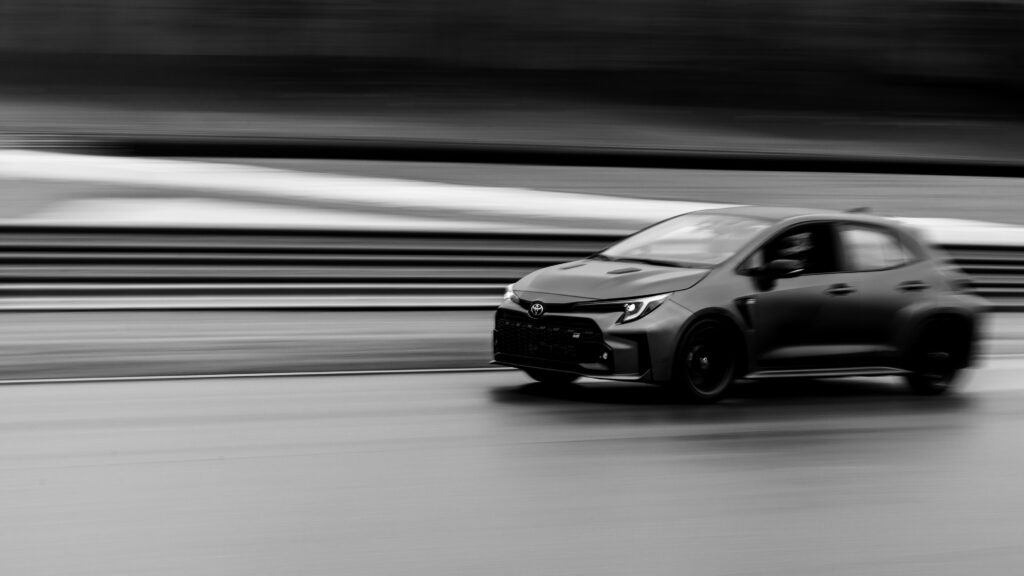
It goes on! As with most three-cylinders, the flywheel is heavy; downshift blips take an occasionally awkward boot of throttle, and rev hang is substantial. The electrically assisted steering is accurate but dull; its most useful bit of feedback comes whenever you hit the front diff with too much load, throttle, and steering at the same time, the wheel going momentarily heavy and dead.
It goes on even further! Depending on your perspective, the shifter is either charmingly mechanical or annoyingly clunky and heavy. Either way, the synchros can present as high-effort, as if the clutch wasn’t fully bled. (We checked; it was.) Wide pedal spacing makes heel-and-toeing a difficult, sideways-foot operation.
Again, Morizo G-Rollas lack a rear seat. That said, few people over five-eight can sit in the back of a current Corolla hatch for more than 40 minutes without desperately wanting out. You either know you need that bench or you don’t care. Upside: With the seat deleted, the car can carry four of its own wheels upright and secure. (We checked; it was neat.)
- Morizo interior touches: Ultrasuede steering wheel, and . . .
- . . . a rear seat with no rear seat.
Those last three paragraphs contain deeply unimportant details that in no way detract from a fantastic and snorty little spitball of a car, and we shall not speak of them again.
We will now discuss the effects of that console switch, because they are fun.
***
Your Cockpit-Switchable G-Rolla Torque-Distribution Options!

GR: Gazoo Racing. Four: driven wheels. Using the switch itself: Track (50:50 torque distribution front to rear) is likely fastest in most conditions. If you don’t care about that, experiment—which part of the corner do you want to focus on? How wet is the track? Standing water? How deep? Finally, how do you want an all-wheel-drive car to feel?
60:40 Front : Rear, Wet* Pavement: The safest wet setup, the most understeery, and the most brainless to drive. The car feels almost too forgiving and stable, except when it’s impractically not. Traction in this mode usually hangs on steering angle; all else being equal, the front tires generally light up first. Corner entry is finesse is everything.
60:40 Front : Rear, Dry Pavement: As in the wet, but faster and calmer. Like a bad CBS sitcom—kind of interesting at first, then you sigh and change the channel.
*Generally speaking, a broad-stroke summary over varied conditions, from standing water to partially dry “gray.”
- The standard dash display; driveline distribution is shown in a small box at bottom right.
30:70 Front : Rear, Wet: The most entertaining slick-track setup, if not the fastest. More sensitive in fast sweepers, feels the most on edge. Keeping the rear planted—or at least helpfully loose—requires more delicacy on brake and throttle, especially at high speed.
Predictably, this setup gives the least forceful drive off a wet apex. Rear-tire slides generally come earlier in the corner, and those slides take longer to recover on throttle, the front tires slower to pull the car straight. Corner exit is finesse is everything.
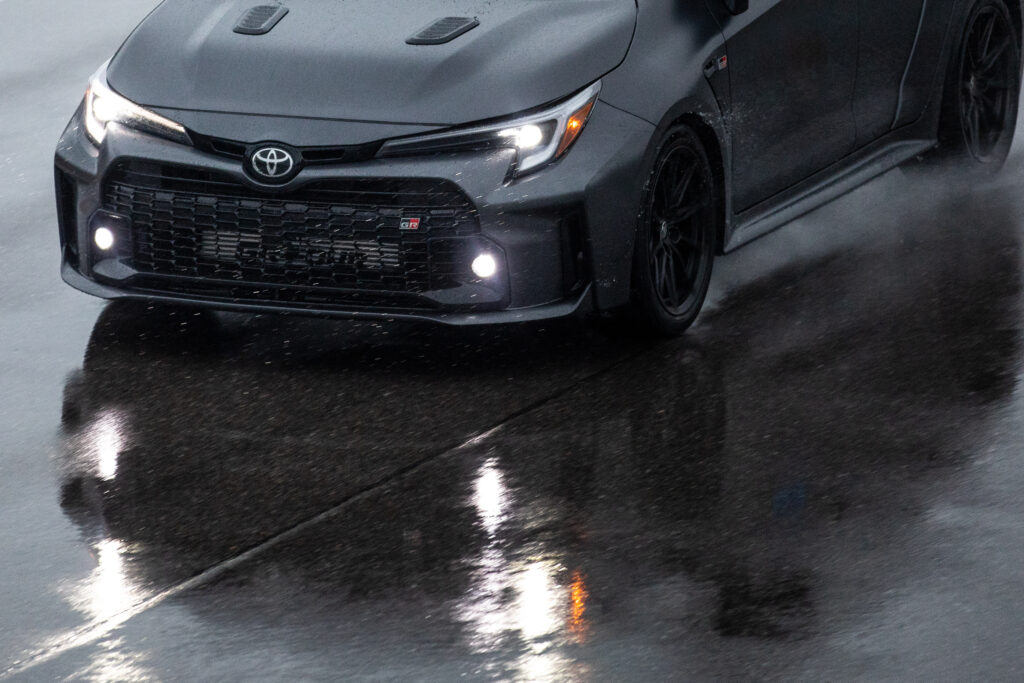
If there’s more standing water, do you want a front driveline bias, to work the car earlier and harder in the corner?
30:70 Front : Rear, Dry: Goofball raucous. As in the wet, but faster and more interesting. Your right foot makes fat drifts if you want. Lightly gimmicky but fun regardless.
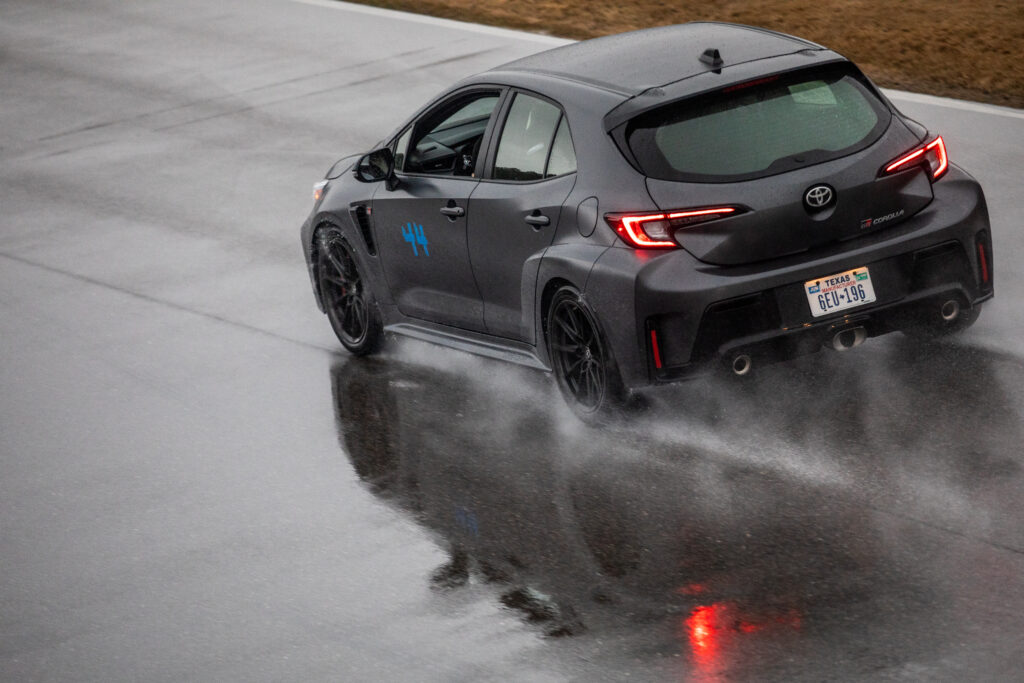
Or do you want a rear bias, where you have to be more delicate on entry?
50:50 Front : Rear**, Wet: A cheat code. Walking outside on the first day of spring. Waking up as a kid and hearing that school has been canceled. Your voicemail, clogged with messages from Sebastién Loeb, who has heard of you from across an ocean and wants to buy drinks.
The car pivots more freely, is more neutral on throttle, is fiendishly reactive to input changes but less forgiving of fools and loudmouths. Deep and late brake on a curb climb just sends the rear bumper snap! to a heading, makes you taller, smarter, thinner, faster.
Pair it with throttle at the right time and you become some kind of giddy tiny-car god, slewing around in tiny delicate bites of steering and wondering how much aftermarket boost the engine will take before a diff goes boom.
The Corolla seems to finally hit full special here. It wants bravery and begs commitment. If you know why it’s good for a rear axle to occasionally try to lead a car on the brakes, all the better. Full chihuahua.
**Track mode only.
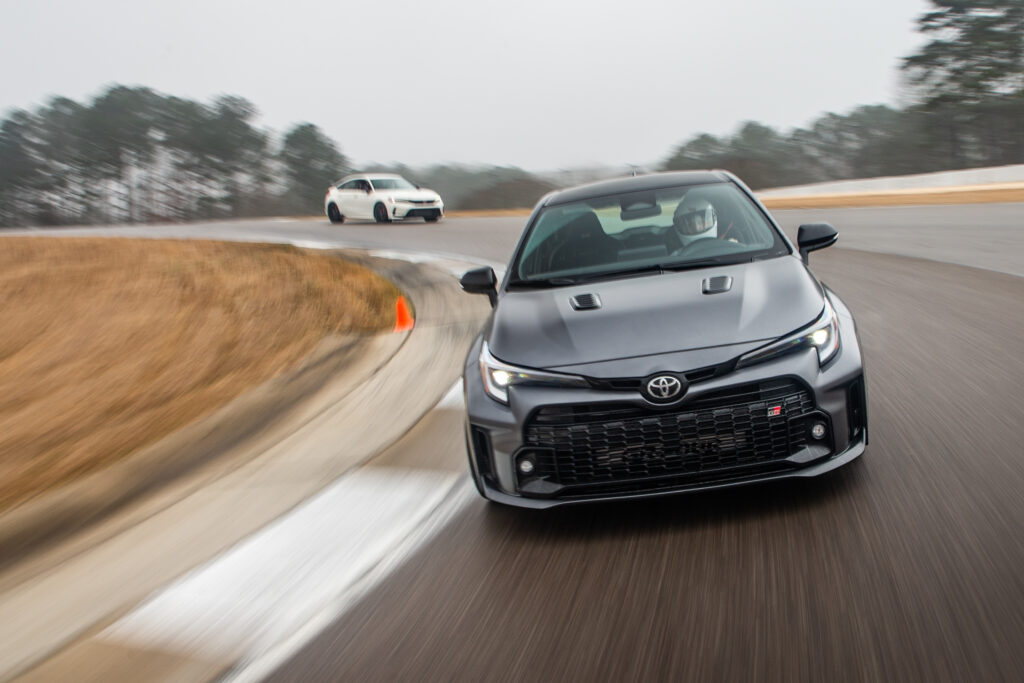
50:50 Front : Rear, Dry: [Cackles.]
***
Is a $51,000 Corolla for everyone? Hell no.
This one is lightly uncomfortable and impractical. It feels like a callback to the time when fast cars demanded compromise—when the good ones were so focused that they couldn’t be all things to all people, when they felt like they came from somewhere specific. You cannot drive a runt like this and take yourself seriously.
Anyone who has spent any time in modern cars knows that this quality is both rare and indescribably lovely. At Barber, between sessions, our crew attempted to describe it anyway. The process mostly just produced phrases like “spicy-boy turbomonkey,” which land as total gibberish until you throw the Toyota around Barber’s hills and dales with the bit in your teeth, and then they kind of make sense.
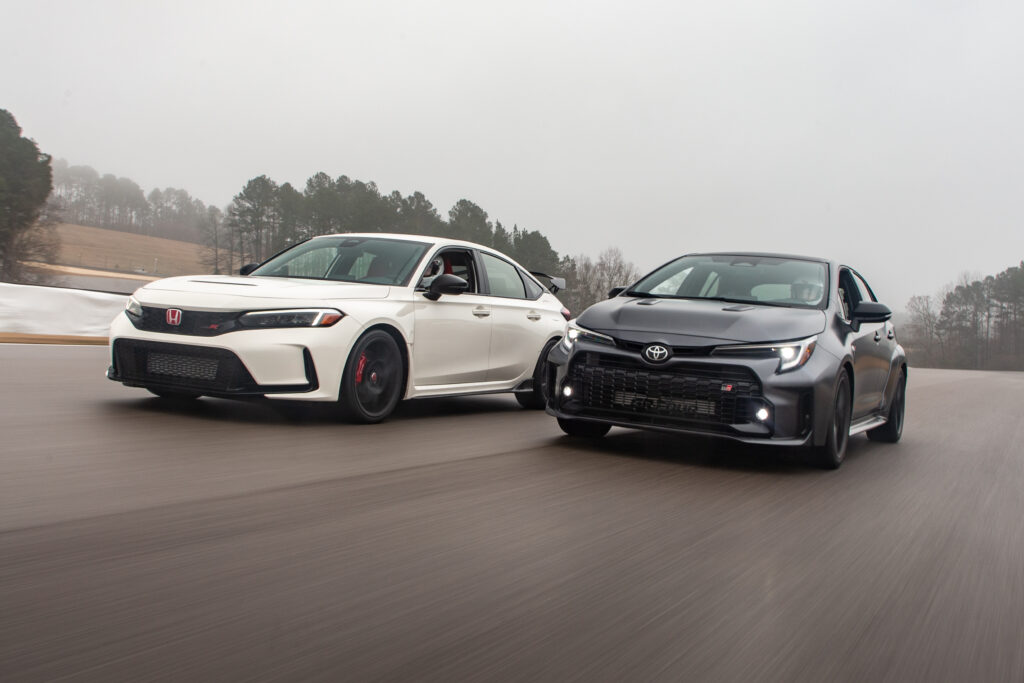
“The Civic you have to meet on its terms,” Weiner said. “It’s more serious, but the more you give, the more it gives back. The Corolla is like, Follow Me Into Oblivion. And you willingly do. It’s wonderful.”
That second afternoon at Barber, while lapping, I began to recite a short song in my helmet. A looping script, repeated while jumping curbs and chasing down things with roll cages:
That’s a Corolla / how can you pass me / I’m a Corvette / That’s a Corolla / how can you pass me / I’m a Corvette / la la la la laaaaaaaaa.
If you have ever driven your socks off to put some gutsy small car deep into the mirrors of more expensive iron, you know one thing about that process:
It never. Gets. Old.
At this very moment, new G-Rollas are being bolted and welded into life on a dedicated line in Motomachi, Japan. Earlier this year, Toyota granted an indefinite production extension to the formerly limited-edition Circuit variant. American demand for the car has apparently exceeded company predictions.
Which can only mean one thing: We’re not alone.
***
2023 Honda Civic Type R
Meet the $44,000 Honda Civic. It makes 315 hp from four cylinders. It has a turbocharger, driven front wheels, a Torsen limited-slip, and electronically adjustable shocks. It comes only as a hatchback, only with a six-speed manual, and only with red seats.
The front tires are steamrollers, 265 millimeters wide, reportedly the largest ever fitted to a production front-driver.
I couldn’t help noticing the absurd entry speed the Civic made with those suckers, then noticing that the fenders had room for more.
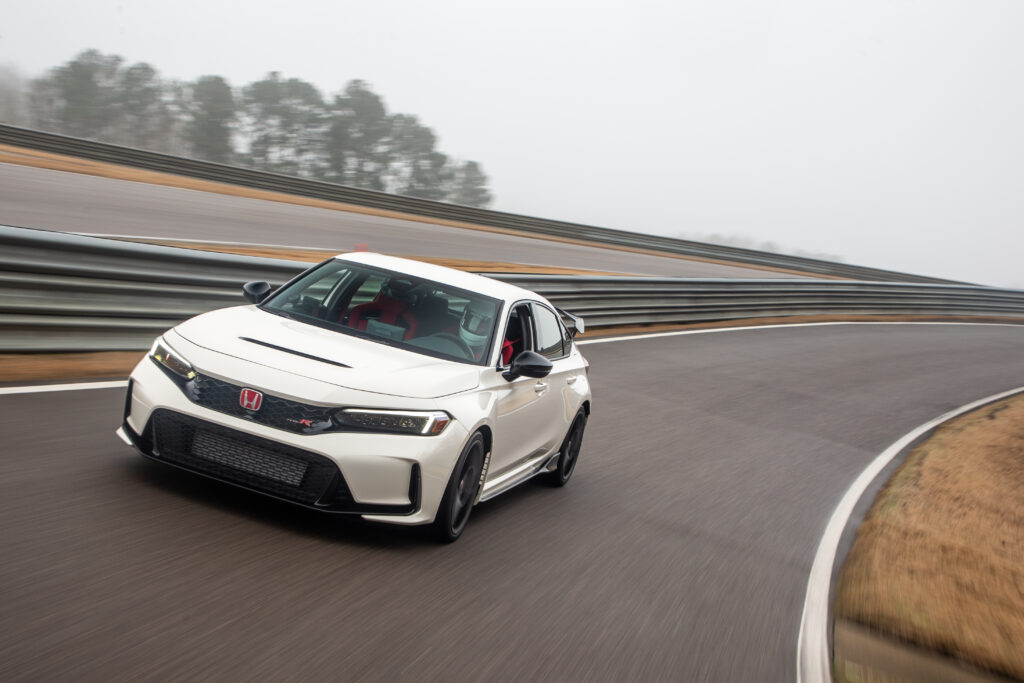
As with the Corolla, people kept walking over to look at it. But really only on the second day, after the rain stopped, once the car had turned laps on a dry track. And there was only one question:
Is it stock?
Yes, we said. Always with the same reaction: Really? Wow.
- Serial-number cockpit plaque, a Type R tradition.
- Wonderbus and runt, Turn 12.
Who would guess they weigh the same? The Civic is 7.3 inches longer and 2.2 inches wider. Its 107.7-inch wheelbase stretches nearly four inches beyond the Toyota’s. The back seat is comically large, as if built for NBA players. The trunk is, to borrow the old Rolls-Royce descriptor, adequate.
Next to the Corolla, the Honda seems another species: school bus with wing stanchions? Championship White train car? Accord Type R?
With Hondas, Type R means the full boat, Racing, all the track speed they can build in under a warranty and a price just short of . . . uncivil. (Get it?) This is the fourth such Honda to be sold in America. First came the 1997–1998/2000–2001 Acura Integra Type R, naturally aspirated and raw. Next was the 2017–2021 Civic Type R, what Honda called FK8, built on the tenth-generation Civic.
The current Type R, the FL5, comes from Civic eleven. The engine is an update of the FK8’s 7000-rpm turbo-four.
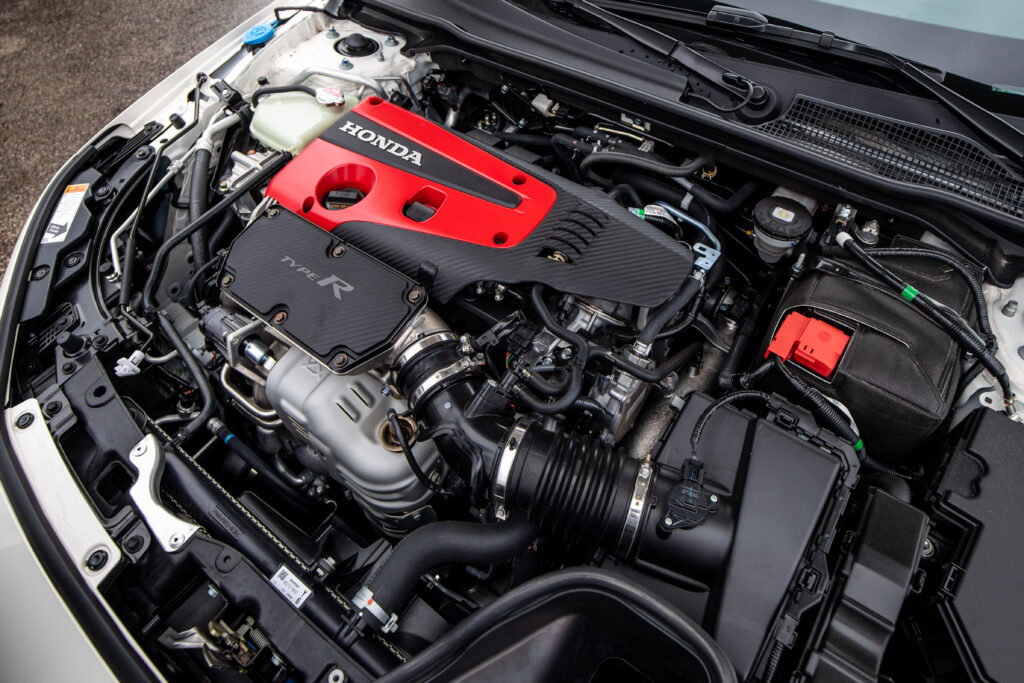
Yes, the red engine cover looks like a Honda portable generator. (And no, the bits underneath aren’t any prettier.)
That Integra, enthusiast shorthand ITR, was simple. Road noise and VTEC-backed engine snarl filled the cabin. The shocks seemed made of concrete and torque was out to lunch, but the engine wore an 8400-rpm redline and the rear axle honked into a fast corner like no front-driver before or since.
Except maybe this one.
The FK8, by contrast, was a turbocharged house cat. Wonderful at the limit, comfy and quiet everywhere else, no ITR anywhere.
The 2023 Type R is even comfier, more quiet.
We were a little bothered by that at first. Later, once the car had been fired into Barber’s fourth-gear, fall-off-a-cliff Turn 1 a few times, nobody cared.
- Aluminum shift knob, more Type R tradition. Simple dash. Center screen, as in base Civic, does not retract.
- R-mode dash graphic mimics the bar tach of Honda’s S2000 roadster.
- They only come in red.
It would be nice, of course, if that linear, torquey four didn’t sound like a vacuum cleaner. If it made the kind of naturally aspirated, high-pitched honk that once defined cars like this and lived nowhere else. It would also be nice if the wheelbase wasn’t a near match for that of an ’85 Cadillac Eldorado (look it up), if that dimension hadn’t grown almost an inch and a half since the FK8, if it was not 6.5 inches longer than the wheelbase of an Integra Type R.
Upside: A long wheelbase can aid stability under braking. So in this case, you can haul down from 130 mph with mad intent and trail the brake just a toe-smidge into the entry of the aforementioned Turn 1, and it works as no stock Type R ever has.
The rear suspension is stiff enough to just pop into entry right there with you, surprisingly quick but welcome, like some balls-out SCCA front-drive production car with a rear sway bar like a sewer pipe. Perhaps like the Acuras that the one and only Peter “RealTime” Cunningham used to fire around in 20-years-ago World Challenge, when I was in high school and easily influenced by such things.
Or at least that’s what you tell yourself. It’s just a road car, heavy and comfy. Hints elsewhere at certain moments, though. Shrinks around the seat.
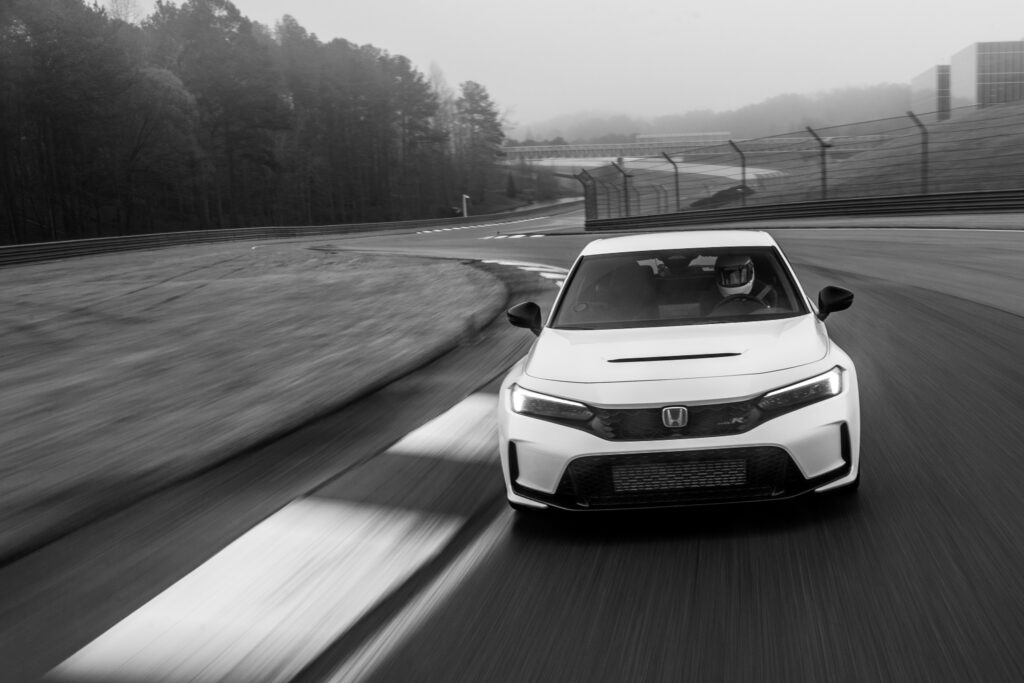
The Toyota, for what it’s worth, pulls the same trick in reverse. Where speed makes the Civic feel wider and shorter, the Corolla seems to grow taller and softer. It moves around more at max brake, is less forgiving in those moments, takes longer to stop. The Corolla’s gearbox also feels more durable; in traditional Honda fashion, the Civic wants a light touch, as if the shift forks were twigs.
Enough generalities. Specifics follow.
- Obligatory seatback branding.
- Obligatory caliper branding and red Honda badge, more Type R tradition.
The bolsters on those red seats are tall and pointy. Firm foam wedges. Rolling legs over as you climb in is a bit of a hassle. Once in, though, you forget they’re there.
There is no turbo lag worth mentioning. That four-cylinder is nice and linear, anodyne but predictable. Little vibration makes its way to the cabin. Midrange torque is a long and smooth rise, accompanied by a hoarse and contralto from the intake. Output falls off just enough near redline to let you shift without watching the tach.
Which is good, because windows down, in a helmet, you can’t really hear the engine.
At times, the Civic can feel lighter than the Corolla. It likes the same kind of scruff-neck treatment but is less fussy about inputs. Where the Honda pivots from your hips, the Corolla seems to turn from your shoulders. (Perhaps the roll centers are higher? I’ll call some engineers and get back to you.)
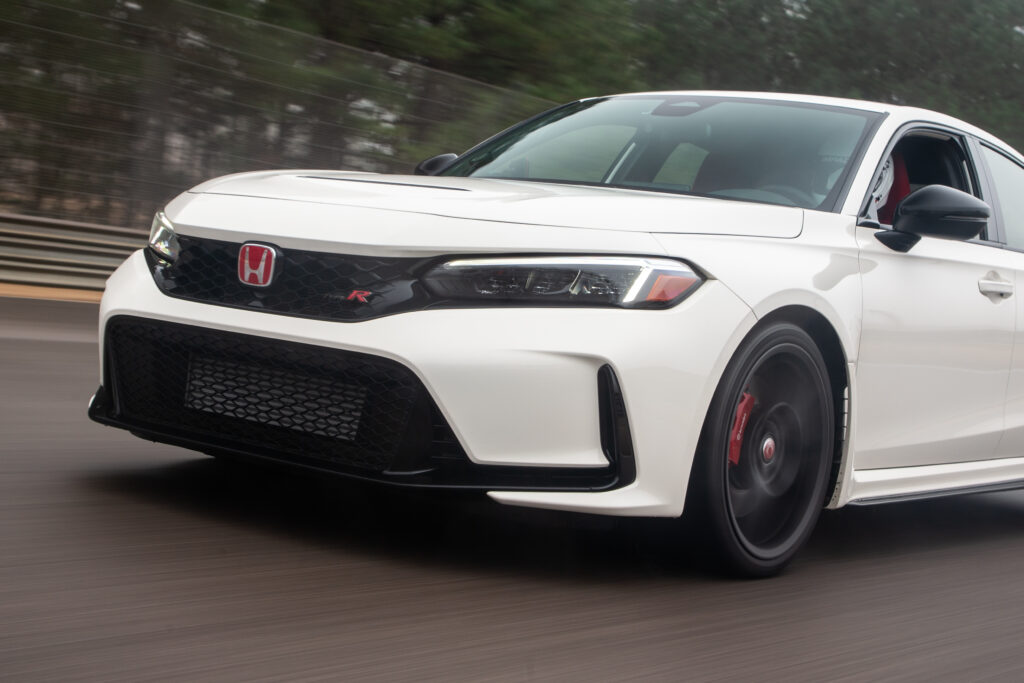
Drive the cars back to back, over and over, watching tires and tenths, you’ll eventually wish for a blend. The Corolla’s mercury-skillet reactivity paired with the Civic’s higher-resolution shocks, its massive turn-in stability, its wheelbase. Where the Toyota can feel loose and wild-eyed, needing quick hands in a slide, the Civic is more composed.
If you are committed, if you give all the big-boy front-drive inputs, it’s a joy.
The Honda’s three chassis modes—Comfort, Sport, and +R—alter steering assist, throttle response, and, critically, damper settings. The variations in steering and throttle are uninteresting and mostly down to taste, but the shocks matter. Sport is generally the best combination of useful and forgiving. The most aggressive setting, +R, initially presents as impractically stiff but can bring a slight uptick in entry speed under certain conditions. Either way, the car is shockingly quick to settle off curbs or fat compressions.
A big smack of unload as you track out over a blind fourth-gear hill and air piles under the front bumper? Done and dusted, don’t think about it, wheels and body calm before you notice.
- Mix-a-lot.
- Mix-a-lot, part two.
Front grip and exit traction with the Cup 2s can prompt you to overuse them. The Honda loves high-speed, high-grip commitment, but the Michelins lose a smidge after running at max effort for a few laps, fall off a bit and don’t come back.
Some combinations of significant steering input and throttle let the diff put a bit of push into the car. As in the Corolla, the wheel will grow muddy at that point, except the Civic can’t shove torque aft like the Corolla, so the Honda slows more, scrubbing slightly wider. Next lap, as remedy, you enter the corner wider or later or tighter, the nose runs more free off the apex, problem solved.
In the wet, the rear slides . . . quickly. Comfort mode helps, the softer shock calibration adding grip and making slides less abrupt.
The rad little Type R-specific bar-graph tach graphic suggests the dash in a Honda S2000, and that’s a compliment.
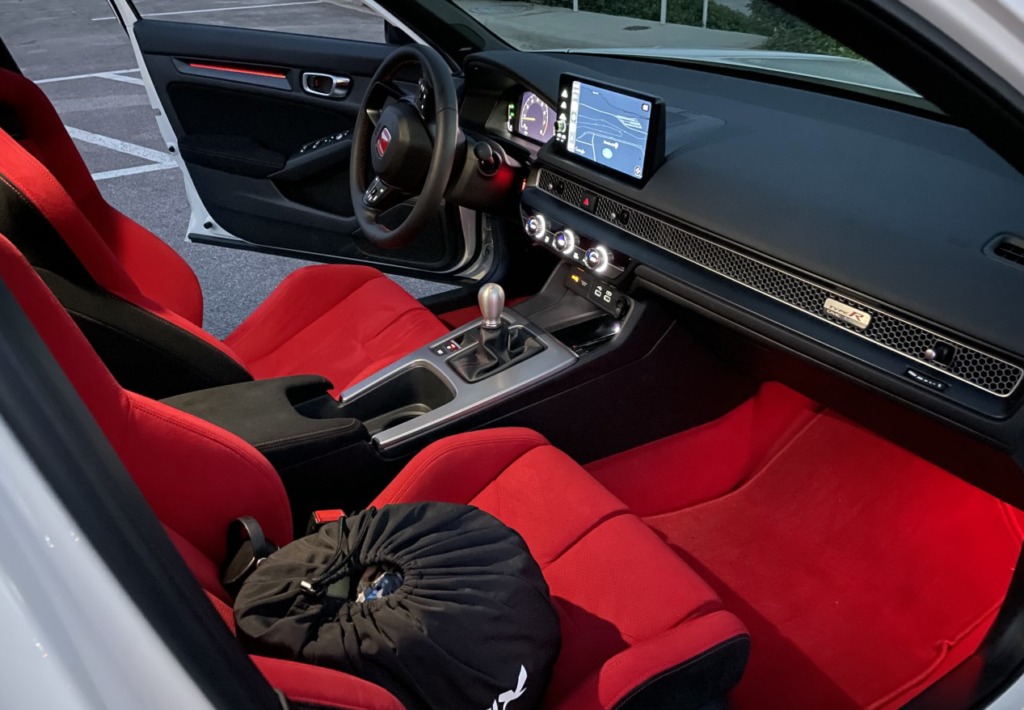
The only available carpet color is . . . great, actually. Very Honda, very Type R. And best described as “bordello.”
Toward the end of the weekend, Eric rode with me for a session. Halfway through a series of sedate banzai laps, he leaned over, shaking his head.
“You are doing,” he yelled, over the open windows, “some insane s*** with this car!”
We blew over an entry curb as if it wasn’t there. “It’s not me!” I laughed. “Pirate Honda!”
Then we went off and hassled more Corvettes. Which is not a task at which one would immediately aim a Civic or a Corolla, but it worked with each, so there you go.
- Mirror glaze.
- Three-pipe Civic exhaust.
“I suspect,” Eric said later, “next to the Civic, the Corolla is more satisfying on the road. It’s not as practical, but it’ll feel more special more of the time. The Toyota was fantastic at Barber, but as somebody who isn’t an amateur racer? The Civic just feels more reassuring.”
“The chassis transparency is what gets me,” I said. “Given how reserved the Civic is beneath, say, seven-tenths. So many front-drive cars, corners are basically just finding an entry speed and waiting on what the front tires can’t do. This is more reactive. Like how the French used to tune front-drive hatches.”
You actually have to work with the Honda, think, be smart. It’s why that last, special little bit of balance—that slippy vibrance at the limit—is so satisfying to find.
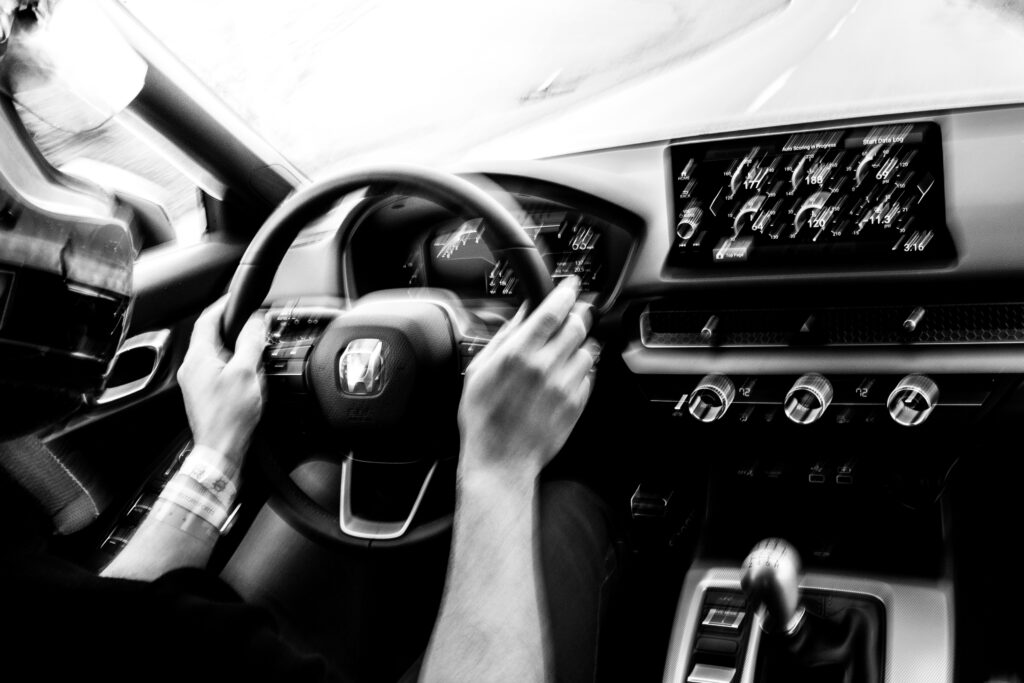
As we packed to head home, I was reminded of something. I owned an Integra Type R for a few years and loved it. The FK8, that last Type R Civic, felt nice but unrelated. This one isn’t a modern ITR, but it at least seems to have come from the same people.
Aimed at the crazies, like the Toyota, just subtle. To a point.
***
Two vastly different cars. All else being equal, at circuits that emphasize neither motor nor handling, they shouldn’t be far apart in pace. If our experience is any guide, the Civic will be slightly faster on a dry track.
In the wet, all bets are off. The Toyota’s traction brings glaring advantage, the ability to gap the Civic by whole seconds if the rain gets thick enough.
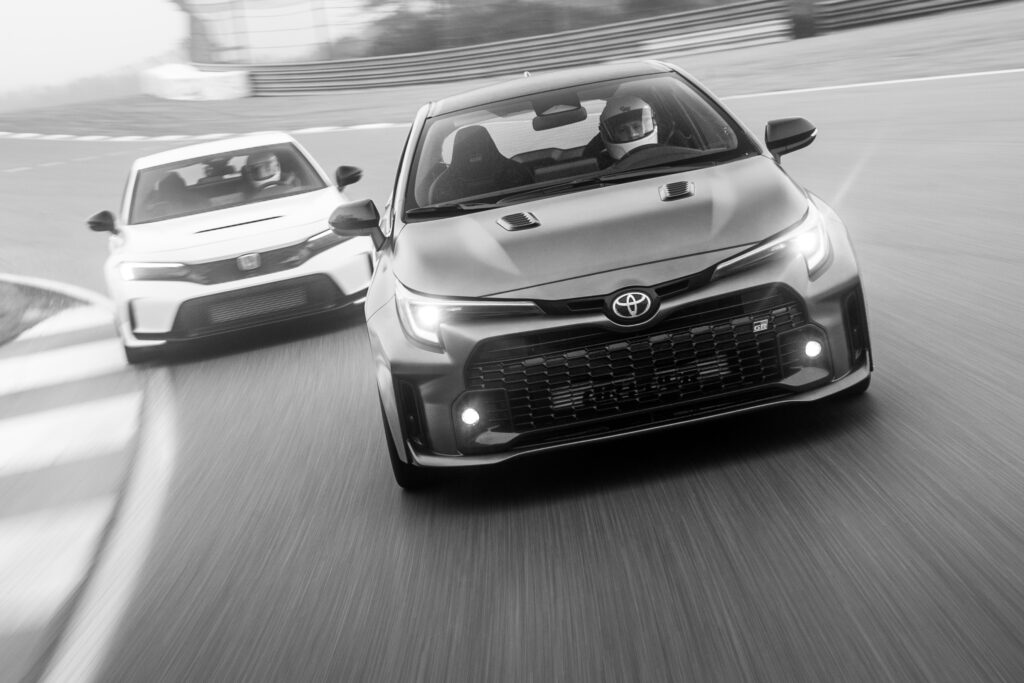
The Toyota is a car for one kind of person, the Honda for another. The former is a playful grin machine and handling chameleon. The latter is a business-first family sled with a secret.
With enough funding, of course—their MSRPs combined are still less than a new BMW M3—you could have both cars. Use one on Mondays, the other on Tuesdays, switch off all week. Keep them in nice shape, eyeing future resale, you could probably run that game for years and not lose money.
What you would lose is sleep—all those hours in bed, late at night, staring at the ceiling, trying to pick one for tomorrow.
***
2023 Toyota GR Corolla Morizo
Price: $36,995* / $52,640** (base / as-tested)
Highs: Chassis balance for the die-hards. Uncompromising focus. One of the last unique internal-combustion engines, in one of the last true enthusiast specials. Feels like the homologation special it is.
Lows: Powerplant can seem a shrinking violet. Heavy, clunky shifter. Steering feel needs a rethink.
Summary: An instant classic, and everything the internet hype says it is. (This is a compliment.)
*GR Corolla Core
**Morizo Edition
***
2023 Honda Civic Type R
Price: $44,390 / $46,625* (base / as-tested)
Highs: Chassis balance for the die-hards. One of the best-handling front-drivers since the Integra Type R. Fantastic seats. The more you give it, the more it gives back. Quiet and comfy, if that’s your thing.
Lows: The largest Civic in history. Engine sounds like an appliance.
Summary: An instant classic, and your narrator will eventually have one. (He would buy the Corolla if he didn’t have kids.)
*includes Championship White paint ($455), Michelin Pilot Sport Cup 2 tires (dealer-installed option, $1780)
***
Special thanks to Greg Miller and ReZoom Motorsports for hosting Hagerty at Barber Motorsports Park this February.
Hagerty paid for two full-price entries at the ReZoom day and received no compensation for this mention. Miller and crew run fine events with an emphasis on seat time, so if you need an intermediate- or advanced-level track day in the Southeast, look them up! —Ed.

